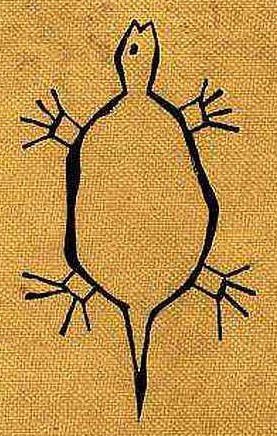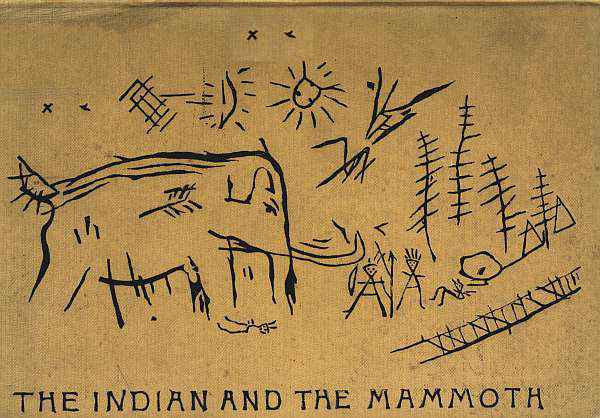
Title: The Lenape Stone; or, The Indian and the Mammoth
Author: Henry C. Mercer
Release date: June 1, 2014 [eBook #45853]
Most recently updated: October 24, 2024
Language: English
Credits: Produced by David Garcia, Paul Marshall, Marilynda
Fraser-Cunliffe and the Online Distributed Proofreading
Team at http://www.pgdp.net (This file was produced from
images generously made available by The Internet Archive)
Transcriber Notes:
Obvious misspellings and omissions were corrected.
Uncertain misspellings or ancient words were not corrected.
Errors in punctuation and inconsistent hyphenation were not
corrected unless otherwise noted.
The underscores before and after words indicate italics in
the original.
Table of Content has been added to this e-book.

Fig. 1.—The Lenape Stone—(actual size)—Aboriginal picture representing Indians fighting the Hairy Mammoth—discovered in Bucks County, Pennsylvania, 1872 and 1881.
OR
THE INDIAN AND THE MAMMOTH
BY
H. C. MERCER
NEW YORK & LONDON
G. P. PUTNAM'S SONS
The Knickerbocker Press
1885
COPYRIGHT BY
H. C. MERCER
1885
Press of
G. P. Putnam's Sons
New York
| TABLE OF CONTENTS |
| PREFACE. |
| THE LENAPE STONE. |
| PART II. |
| APPENDIX. |
In claiming an impartial examination of so extraordinary a carving as the "Lenape Stone" at the hands of archæologists, the writer has had several difficulties to contend with.
First, The fact that the carving is quite unique, it being the first aboriginal carving of the mammoth thus far claimed to have been discovered in North America.
Second, That no "scientific observer" was present at the discovery.
Third, That since its discovery the Stone has been several times cleaned, and that thereby many geological tests of its authenticity have been rendered impossible.
Fourth, That within the last few years, and particularly in Philadelphia, serious frauds have been perpetrated upon lovers of Indian relics.
These considerations may well have been sufficient to prejudice the mind of a stranger against the alleged wonderful Indian relic, yet they should in no case suffice to prevent, on the part of the archæologists, a thorough and impartial examination of all the evidence pertaining to its discovery. [Pg iv]
In presenting this and other evidence, the writer has wished only to be impartial, and to be led by the facts as they have presented themselves, and for the examination of which his opportunities have been peculiarly favorable.
In his knowledge of the neighborhood and its people (his home), an acquaintance with all the persons concerned, and very frequent visits to the Hansell Farm, nothing has yet occurred to shake his faith in the unimpeachable evidence of an honest discovery. Yet should any fresh light be brought to bear upon the subject, however at variance with this opinion, it will be welcomed.
The appearance in America of a carving of the hairy mammoth, presumably the work of our aborigines, if not a surprise to students of archæology, would certainly be no less interesting than the French discoveries of some twenty years ago; while the ready connection of the work with the Indian of comparatively recent times, the appearance of human figures in the carving, and of many symbols which seem related to highly important branches of archæological study, would awaken a more general and enthusiastic interest in the Stone, than has been felt for any other prehistoric representation of the great elephant.
A disbelief in its authenticity would leave us with an interest, not inconsiderable, in the unknown person who, after months of careful study and preparation, could have conceived and executed so remarkable a fraud.
ERRATA.
Page 81, line 2, for Delaware read Susquehannok.
Page 81, line 4, for Delaware read Susquehannok.
In the spring of 1872, eight years after the discovery of the famous mammoth carving in the cave of La Madeleine, Perigord, France, Barnard Hansell, a young farmer, while ploughing on his father's farm, four miles and a half east of Doylestown, Bucks County, Pennsylvania, saw, to use his own words, a "queer stone" lying on the surface of the ground, and close to the edge of the new furrow. The plough had just missed turning it under. He stopped and picked it up; it was the larger piece of the fractured "gorget stone," in fig. 1, (frontispiece). By wetting his thumb and rubbing it he could see strange lines and a carving representing an animal like an elephant, but without troubling his boyish head much about it, he carried it several days in his pocket, and finally locked it up in his chest, where, along with his other relics, arrow-heads, spear-points, axes, and broken banner stones, thrown in from time to time as he found them on the farm, it remained until the spring of 1881, when he sold it to Mr. Henry Paxon, son of a well-known resident of the neighborhood, then a youth of nineteen, and with a fancy for collecting Indian antiquities, in whose [Pg 2] possession it still remains.[A] At the moment of the purchase no particular attention had been paid to the carvings, and the new owner was not certain that he had noticed the mammoth while at Hansell's house, or until a few hours later, when he had brought home his trophies and shown them to his father, who distinctly remembers calling his son's attention to the rude outline of an elephant upon the stone.
But without doubt the singular part of the story is the unexpected finding of the smaller piece of the fractured stone a few months later. After many ineffectual searches for it in the intervening years, it was picked up by Hansell while corn-husking with his brother in the same field and at the same spot where nine years before the first piece had been found. This luckily discovered fragment Hansell presented to Mr. Paxon. Several persons of the neighborhood had seen the stone at Mr. Paxon's house both before and after the discovery of the second piece, but it was not until both parts had been some months in his possession that any unusual interest was attached to it even by him.
Some time in July, 1882, Captain J. S. Bailey, of the Bucks County Historical Society, to whom the writer in preparing the present article must acknowledge his great indebtedness, and who first called serious attention to the archæological value of the stone, made it the subject of a paper read before the Society, but since that time, [Pg 3] although displayed at a county exhibition and twice shown at meetings of the Society above mentioned, this remarkable relic has remained unheard of.
This is the simple story of most great archæological discoveries; no "man of science" was at hand to analyze the condition of the surrounding soil, or satisfy himself that a fraud had not been committed, and a hundred questions now arise as to the finder of the stone, and its present owner, its long unrecognized importance, the whereabouts of Bucks County, Pennsylvania, etc., etc. The "modern scientist" will by no means be satisfied with such evidence as would be held sufficient in a court of law, and every fraud that has been perpetrated upon the lover of Indian relics adds to the necessity of carefully examining each detail of the discovery—nothing must be believed except upon the strongest evidence.
For a full discussion of this evidence the reader is referred to the appendix.
Several circumstances seem to concur in adding to the novelty of the discovery. In the first place the carving has been made upon one of the so-called "gorget stones," than which no class of Indian relics have been more puzzling to archæologists. Our museums are well-supplied with these mysterious perforated tablets of slate, generally resembling in size and shape the stone represented in fig. 1, and which are found in all parts of the United States. Ornaments, talismans, breastplates, or buttons, as we may choose to call them, they seem to have been the peculiar property of the [Pg 4] North American Indian, without a counterpart, as far as the writer can learn, in the stone implements of other uncivilized races. They seem often to have been buried with the dead warrior and when discovered in Indian graves are generally close to the breast of the skeleton.[B] Gorgets are frequently scratched and scribbled upon, and ornamental zig-zags and cross-lines, like the faint scratches plainly to be seen on the Lenape stone crossing the carvings in all directions, are not uncommon on these stones, pipes, banner stones, and other Indian implements; but picture-writings proper, such as are commonly found painted upon buffalo robes, scratched upon birch bark, or carved upon the face of cliffs or large boulders, are exceedingly rare on small stones, and the tablet in question is the only known instance, the writer believes, of a pictured gorget. The carving, when compared with the larger and more conventional Muzzinabiks or rock-writings and birch-bark records of the Indians, seems to lack much of the symbolic obscurity common to these productions of the prophets and medicine men. It doubtless belongs [Pg 5] to the less hieratic class of writings, known among the Algonkins as "Kekeewin," which dealt with things generally understood by the tribe.
It is unquestionably a picture of a combat between savages and the hairy mammoth—an encounter such as our imagination has not yet connected with the ancient forests of America, and drawn as well as an Indian who had seen the great monster could have drawn it. Most of the figures seem represented according to the common conventional method of the modern Indians, yet there is certainly a seeming picturesque relation between them of which we can find no example in the few ancient Indian pictographs which have been preserved to us. We can almost fancy a foreground, a distance, and a faint chiaro-oscuro.
The combat we might imagine takes place on the confines of a forest, and if we may judge from an upward inclination of the foreground on the right, at the base of a hillside. The monster, angry, and with erect tail, approaches the forest, in which, through the pine trunks, are seen the wigwams of an Indian village. In the sky overhead, and as if presiding over the event, are ranged the powers of heaven: forked lightning flashes through the tree-tops, and from between a planet and the crescent moon, beyond which we seem to see a constellation (represented by a series of crossed lines) and two stars, the sun's face looks down upon the scene. Four human forms confront the monster, the first holds in his right hand a bow from [Pg 6] which the arrow just discharged is sticking in the side of the enraged beast, and in his left, if it is not planted in the ground, a long lance; a second warrior with head-dress of feathers stands farther to the right; and still farther, and near what may perhaps be called a rock, a third sits upon the ground apparently smoking a pipe. A fourth figure is easily distinguishable trampled under the fore feet of the mammoth.
The strong effect upon the fancy of the rude carving, as we gaze upon it, would be hard indeed to resist. Its stern naïveté and characteristic lack of æsthetic purpose bring upon the mind a haunting sense of the reality of the event it represents, and our sympathies seem genuinely awakened for the four human beings who have dared to confront the monster with their rude weapons of stone, yet whose destiny, like that of their huge antagonist, is overshadowed by the near presence of a supernatural power, seen in the great phenomena of nature which the artist has connected with the scene. Well might the appearance of the hairy mammoth have excited in the superstitious mind of the Indian hunter fancies more wild than those contained in the carving. Hardly more thrilling could have been the coming of the white men in ships, or the sound of their cannon, than the sight of one of these ungainly monsters in the shadows of a primeval forest, or the crash of his irresistible advance through the underbrush.
[Pg 7] Beckendorff, a Russian engineer, who, in 1846, saw a carcass entire, "a black, horrible, giant-like mass," floating on one of the rivers of Siberia, declared that its appearance to that of a modern Indian elephant was as "that of a coarse ugly dray-horse to an Arab steed." He also noticed a ridge of stiff hair like a mane about a foot in length and extending above the shoulders and along the back.
Its size, like that of the modern elephant, must have varied considerably. The famous St. Petersburg skeleton measures but nine feet in height, while that in the Royal Museum of Natural History in Brussels reaches eleven feet, and the animal in the carving, judging from the relative size of the figures, would have been still larger than Beckendorff's carcass, which he declares measured thirteen feet in height. Geology tells us much of the aspect, epoch, habits, and range of the mammoth; that it had appeared later than the mastodon, and somewhere in the age known as the Pliocene; that there were several species—three at least—two of which were inhabitants of America; that in North America it ranged from Behring Strait to the Gulf of Mexico, and in Europe from the extremity of Eastern Siberia as far south as Rome and the Pyrenees; that it fed upon the branches of the fir, birch, poplar, willow, etc., and was probably migratory in its habits, wandering toward grazing grounds in the north in summer, and southward in winter. [Pg 8]
The long shaggy hair with which it was clothed, distinguishing it in appearance from the modern elephant and its smaller contemporary, the mastodon, was composed of three distinct suits: the longest, rough, black bristles, about eighteen inches in length; the next, a coat of finer close-set hair, fawn-colored, from nine to ten inches long; and the last, a soft, reddish wool, about five inches long, filling up the interstices between the other hair, and enabling the animal to withstand an arctic cold.
The enormous tusks measured along the curve from eleven to fifteen feet, and curved quite abruptly outward and backward.
The massive grinder, sometimes weighing seventeen pounds, was a conspicuous characteristic; the whole of its surface was not brought into use at once, but successively, new grinding-points being formed from behind as the outer and older points wore away.
Several etymologies have been given for the name "mammoth"; among others, the word "behemoth" in the Book of Job, and the Arabic word "mehemot," signifying an elephant of very large size. One of the most interesting is the Tartar word "mamma," meaning the earth, suggested by Pallas, a Russian scientist, who first gave a description of the animal. "The Tungooses and Yakoots," he says, "believed that this animal worked its way in the earth like a mole. The mammoths had retired, they say, into great caverns from which they never emerge, but wander to and fro in the galleries; [Pg 9] and as they pass into one the roof of the gallery rises, and the roof of the one just vacated sinks. The moment this animal sees the light it dies, and the reason why so many carcasses have been exposed to view is because of their having been deceived by the irregular conformation of the earth's surface, thus unintentionally venturing beyond the confines of darkness."[C]
Mastodon and mammoth bones have been discovered in Europe from the earliest times, and a history of the remarkable theories to which they had given rise before the time of Cuvier is very interesting. By the learned of by-gone times the fossils have been mistaken for the bones of Ajax, the "body of Orestes," unicorns, the teeth of St. Christopher, and the remains of Hannibal's elephants. The middle ages have given us a whole library on the subject of a race of giants, whose remains were clearly recognized in the huge bones.
In America, in colonial times, Governor Dudley, of Massachusetts, was "perfectly of opinion" that the mastodon tooth discovered near Albany in 1705 "will agree only to a human body, for whom the flood only could prepare a funeral; and without doubt he waded as long as he could keep his head above the clouds, but must at length be confounded with all other creatures."
At what period the monster became extinct in Europe is a question to which geology gives no answer from the [Pg 10] point of view of human history. The evidence rests upon the variously computed age of the beds in which the fossil bones occur. In France, for instance, it is known that the mammoth, whose bones are found in the strata underlying, and therefore older than, the Somme Valley peat, became extinct before the peat stratum, thirty feet thick, which contains no bones, had formed. It had grown, says M. Boucher de Perthes, at the rate of three inches in a hundred years; and if, as geologists say, the mammoth bones of Niagara Falls were deposited in their bed before six miles of the present river gorge were worn by the cataract out of the solid rock, they may be, according to Lyell, 31,000, or Desors, 380,000 years old.
In Siberia, whence most of our information comes, many carcasses of these huge animals have been found preserved entire in the frozen mud. When and how did they perish? Possibly, says the geologist, all at once, overwhelmed by some sudden cataclysm, which, burying the carcasses in the mud, was immediately followed by an intense cold that has lasted ever since; possibly, again, great freshets in the northern rivers, overtaking the migrating herds, swept their carcasses from warmer regions to the shores of the Polar Sea.
In Europe, the fact that the mammoth survived into the human period was proved some years ago by the discovery of human stone implements associated with mammoth bones in the river gravels of the Somme Valley, France, and in the Virgin Cave at Brixham, South [Pg 11] Devon, England; but more interesting still, was the discovery of prehistoric carvings of the great elephant, sketches from nature made by the "cave-men," and found in their subterranean dwellings along the river Dordogne in France, illustrations of which will be given in the following pages.
In America, we have traces of a race of savages as old or older than the now famous river-drift and cave-men of Europe. Since the "Calaveras Man" lived, a valley, say geologists, has been metamorphosed, by the slow processes of nature, into a mountain; and the "San Joachim plummet," the "Trenton gravel-flints," and stone implements from the gold-bearing gravels of California, all speak of a race of human beings who must have lived in the time of the hairy mammoth.
But who were these people? Were they Indians? or had the Indian or his ancestor the mound-builder not yet appeared? and how many thousands or tens of thousands of years ago did they exist? These are questions which archæology has not yet answered.
Here, however, with the carving before us we need not go back so far, nor beyond the Indian as we know him—the fierce, roving, bauble-loving, picture-making hunter of to-day. A study of the wonderful outlines on the stone will lead us through a period of his history extending over many hundreds, perhaps thousands, of years before the coming of Columbus; and here we may try to read, from the few vestiges of this time that chance has preserved [Pg 12] to us, fragments of his picturesque mythology, strange legends of his origin and wanderings over a forest-covered continent, and the thrilling story of the mound-builders, and of long wars when the forest soil for centuries was a "dark and bloody ground."[D]
That the mammoth had survived into the time of the Indian can hardly be doubted. Early travellers had frequently seen its bones at the "Big-Bone Licks" in Kentucky, whither the huge animals had come, like the deer and buffalo of modern times, to lick the salt. The great bones often seemed hardly older than those of the modern animals with which they were mingled, and, judging from their position along the modern buffalo-trails through the forest, it seems that the latter animals had followed the ancient tracks of the mammoth to and from the licks.
Not a few of these early travellers thought it worth their while to question the Indians about the huge bones and note down their answers. Jefferson, in his "Notes on Virginia," devotes several pages to the subject. He even believes the mammoth to be still in existence in his time in some remote part of the American continent. He tells the story of a Mr. Stanley, who, "taken prisoner by the Indians near the mouth of the Tanissee," relates that "after being transferred through several tribes from one to another, he was at length carried over the mountains west of the Missouri to a river which runs westwardly; [Pg 13] that these bones abounded there, and that the natives described to him the animal to which they belonged as still existing in the northern parts of their country, from which description he judged it to be an elephant."
Further, in support of his theory, he gives an Indian tradition of a great monster known as the Big Buffalo, and obtained, he says, from a Delaware chief by one of the governors of Virginia during the American Revolution. Nothing has seemed more interesting in a study of the carvings on the Lenape Stone than the remarkable similarity between this tradition of the Lenni Lenape or Delawares and the carvings on this relic, discovered in the middle of their ancient territory. The chief, as the account runs, being asked as to the bones at the Big-Bone Licks in Kentucky, says that it was a tradition handed down from his fathers that "in ancient times a herd of these tremendous animals came to the Big-Bone Licks and began a universal destruction of the bear, deer, elks, buffaloes, and other animals which had been created for the use of the Indians. That the Great Man above, looking down and seeing this, was so enraged that he seized his lightning, descended on the earth, seated himself on a neighboring mountain, on a rock on which his seat and the print of his feet are still to be seen, and hurled his bolts among them till the whole were slaughtered except the big bull, who, presenting his forehead to the shafts, shook them off as they fell; but missing one at length, it wounded him in the side, whereon, [Pg 14] springing around, he bounded over the Ohio, over the Wabache, the Illinois, and finally over the great lakes, where he is still living at this day."
Making due allowance for translation, and a reasonable amount of garbling, the points of similarity between the carving and the tradition—the great man above (the sun) looking down, the lightning, and the big bull presenting his forehead to the shafts, and at length wounded in the side—are very striking; and if we compare the curious circle enclosing a dot, on the inclined foreground to the right, with the "neighboring mountain," and the footprint on the rock of the tradition, the correspondence seems again too unusual for mere coincidence. On the other hand, the tradition says nothing of warriors or wigwams, or of planets, moon, and stars, yet these differences may naturally be accounted for if we suppose the stone older than the tradition, and that in the latter the local and matter-of-fact elements of time, place, and human agency would have been the first to fade away as time went on. But this is not the only Indian tradition of a great monster—presumably the mammoth—which has been preserved to us.
The element of divine wrath, common to monster myths among barbarous peoples, again occurs in a Wyandot version of the same tradition, taken down from a band of Iroquois and Wyandots by Colonel G. Croghan, at the Salt Licks in Kentucky in 1748, and given in Winterbotham's "History of the United States," vol. iii., page 139. [Pg 15] The head chief, says the writer, having been flattered with presents of tobacco, paint, ammunition, etc., on being asked about the large bones, related the ancient tradition of his people as follows: "That the red man, placed on this island by the Great Spirit, had been exceedingly happy for ages, but foolish young people forgetting his rules became ill-tempered and wicked, in consequence of which the Great Spirit created the Great Buffalo, the bones of which we now see before us. These made war upon the human species alone, and destroyed all but a few, who repented and promised the Great Spirit to live according to his laws if he would restrain the devouring enemy; whereupon he sent lightning and thunder, and destroyed the whole race in this spot, two excepted, a male and female, whom he shut up in yonder mountain, ready to let loose again should occasion require."
David Cusic, the Tuscarora Indian, in his history of the Iroquois, among other instances, speaks of the Big Quisquis, [E] a terrible monster who invaded at an early time the Indian settlements by Lake Ontario, and was at length driven back by the warriors from several villages after a severe engagement; and of the Big Elk, another great beast, who invaded the towns with fury and was at length killed in a great fight; and Elias Johnson, the Tuscarora chief, in his "History of the Six Nations," speaks of another monster that appeared at an early period in the history of his people, "which they called Oyahguaharh, supposed to [Pg 16] be some great mammoth who was furious against men, and destroyed the lives of many Indian hunters, but who was at length killed after a long and severe contest."
Another instance of a terrible monster desolating the country of a certain tribe "with thunder and fire" appears in a collection of Wyandot traditions published by one William Walker, an Indian agent, in 1823; and again the great beast appears in the song tradition of the "Father of Oxen," from Canada, and in a monster tradition from Louisiana, both spoken of by Fabri, a French officer, in a letter to Buffon from America in 1748.
"The Reliquæ Aquitanicæ," published by Lartet and Christy, page 60, quotes a letter from British America of Robert Brown to Professor Rupert Jones, which speaks of a tradition common to several widely separated tribes in the Northwest, of lacustrine habitations built by their ancestors to protect themselves against an animal who ravaged the country a long time ago.
Hardly less remarkable in its description of the animal than any of the others is, perhaps, the Great Elk tradition as mentioned by Charlevoix in his "History of New France."
"There is current among these barbarians," says the author, "a pleasant-enough tradition of a Great Elk, beside whom all others seem like ants. He has, they say, legs so high that eight feet of snow does not embarrass him, his skin is proof against all sorts of weapons, and he has a sort of arm which comes out of his shoulder and which he uses as we do ours." [Pg 17]
Whatever we may have previously thought of these legends, their evidence now combined with that of the carving is irresistible. Nothing but the mammoth itself, surviving into comparatively recent times and encountered by the Indians, could suffice to account for the carving, and we can no longer suppose that the size and unusual appearance of the mammoth bones seen by the Indians in Kentucky could alone have originated the traditions.
In the carving, we have the most interesting mammoth picture in existence; not a mere drawing of the animal itself, but a picture of primitive life, in which the mammoth takes a conspicuous part in the actions and thoughts of man,—a carving made with a bone or flint instrument upon a tablet of slate at least four hundred years ago,—the hairy elephant, drawn in unmistakable outline, and attacked by human beings,—a battle-scene which thrills our imagination, and the importance of which the ancient draughtsman magnifies by the introduction of the symbols of his religion, the sun, moon, and stars, and the lightning alone powerful to overthrow the great enemy.
All is evidently the work of the Indian; so would he rudely carve trees, the pine with its straight-spreading arms, like a modern telegraph pole; his forest wigwam, a simple triangle; the sun, with human face, and a halo; and the moon, a crescent; the stars were small crosses, and diverging lines were the rays of light that traversed the sky from the great luminaries. Men were triangles with their sides produced, and three dots in the head for [Pg 18] eyes, nose, and mouth; here the minute forms standing their ground before the great beast, are warriors, with feathers in their hair, and bows and lances in their hands. The chief figure, the great buffalo, or the great elk of Charlevoix, armed with a proboscis, as the Indians may well have named the mammoth, is assailed, as in the Jefferson tradition, by lightning.
Between such a monster, however inoffensive in its habits, and the Indian hunter, there could be no peace; his size and terrific appearance were enough for the superstitious fancy of the red man, and as he browses harmlessly near the village he is attacked; then his rage transforms him into the fierce enemy and destroyer of mankind remembered in the traditions. As naively represented in the carving, he tramples men to a pulp under his feet with the ungovernable fury of a modern elephant, and overturns whole villages of fragile wigwams, while his anger perhaps vents itself in loud bellowings; arrows and spears only annoy him; he must be destroyed by the lightnings of the Great Spirit to whom the medicine men pray for help.
A remarkable story, alleged in support of the coëxistence of the Indian, and the mammoth's great contemporary the mastodon, regarded by most scientists with distrust, though defended by some, was that of Dr. Albert Koch, a collector of curiosities, who in 1839 disinterred the skeleton of a mastodon in a clay bed near the Bourboise River, Gasconade County, Missouri. Associated with [Pg 19] the bones Koch claimed to have discovered, in the presence of a number of witnesses, a layer of wood-ashes, numerous fragments of rock, "some arrow-heads, a stone spear-point, and several stone axes," evidencing he claimed, that the huge animal had met its untimely end at the hands of savages, who, armed with rude weapons of stone and boulders brought from the bed of the neighboring river, had attacked it, while helplessly mired in the soft clay, and finally effected its destruction by fire.
Koch also published with his statement and in connection with another skeleton, that of the Mastodon giganteus discovered by him in Benton County, Missouri, a tradition of the Osage Indians, in whose former territory the bones were found, and which he says led him to the discovery. It states, says Koch, "that there was a time when the Indians paddled their canoes over the now extensive prairies of Missouri and encamped or hunted on the bluffs. That at a certain period many large and monstrous animals came from the eastward along and up the Mississippi and Missouri rivers, upon which the animals that had previously occupied the country became very angry, and at last so enraged and infuriated by reason of these intrusions, that the red man durst not venture out to hunt any more, and was consequently reduced to great distress. At this time a large number of these huge monsters assembled here, when a terrible battle ensued, in which many on both sides were killed, and the remnant resumed their march toward the setting sun. Near the bluffs which are at [Pg 20] present known by the name of the Rocky Ridge one of the greatest of these battles was fought. Immediately after the battle the Indians gathered together many of the slaughtered animals and offered them up on the spot as a burnt sacrifice to the Great Spirit. The remainder were buried by the Great Spirit himself, in the Pomme de Terre River, which from this time took the name of the Big-Bone River, as well as the Osage, of which the Pomme de Terre is a branch. From this time the Indians brought their yearly sacrifice to this place, and offered it up to the Great Spirit, as a thank-offering for their great deliverance, and more latterly, they have offered their sacrifice on the table rock above mentioned (a curious rock near the spot of the discovery), which was held in great veneration and considered holy ground."
There is considerable variety of opinion of late, and especially among persons familiar with the Indians, as to the value of the information furnished by their traditions; and certainly among Indians to-day the separation of their pre-Columbian from their later traditions, and their traditions proper from the extravagant relations so readily dealt forth by them extempore, is no easy matter. Much stress is laid on the absence of a tradition of De Soto; yet, as Schoolcraft remarks, the Delawares and Mohicans had in his time one of Hudson, the Chippeways of Cartier, and the Iroquois one of a wreck on a sea-coast, and the extinction of an infant colony, probably Jamestown. [Pg 21]
Interest in the American elephant has of late been considerably increased by the appearance of several supposed representations of the animal among the relics of our aborigines, drawings of which, and of the so-called elephant trunks, and head-dresses from the architecture of Mexico and Central America, are given in the following pages.
[Pg 22]Not one of these outlines is unmistakable, and all lack the characteristic tusks of the mammoth.
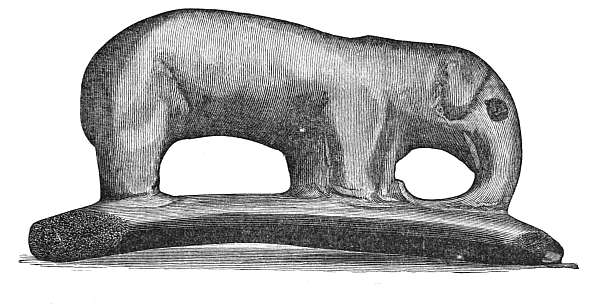
Fig. 2.—Elephant Pipe (Louisa Co., Iowa).
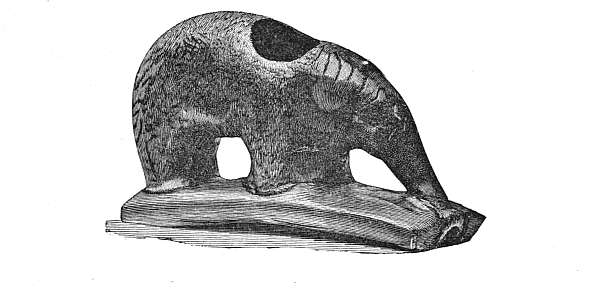
Fig. 3.—Elephant Pipe (Louisa Co., Iowa).
Figures 2 and 3, the now famous "elephant pipes," the authenticity of which is doubted, however, in the last report of the Bureau of Ethnology, came to light in Louisa County, Iowa. The former, discovered in 1872 or 1873, was found, it is said, on the surface by a farmer while planting corn; and the latter, more interesting from the scratches upon it evidently intended to represent hair, was taken from a mound near an old bed of the Mississippi by the Rev. Dr. Blumer and others on March 2, 1880. The material of the two pipes, which apparently have been much greased and smoked, is the same—a light-colored sandstone.
The next of the elephant documents is the so-called elephant mound of Grant County, Wisconsin, (fig. 4). It was described by Mr. Jared Warner, of Patch Grove, Wisconsin, on page 416 of the "Smithsonian Report for 1872," when public attention was first generally called to it. The effigy, 135 feet long, 60 feet broad, and but 5 feet high, is situated on the east bank of the Mississippi, just below the mouth of the Wisconsin, and, says Mr. Warner, has been known in the neighborhood of Patch Grove for twenty-five years as the "elephant mound." Like the elephant pipes, however, it lacks the characteristic tusks, and sceptics claim that its original shape has been too much modified by many years of cultivation to render judgments concerning it admissible. [Pg 23]
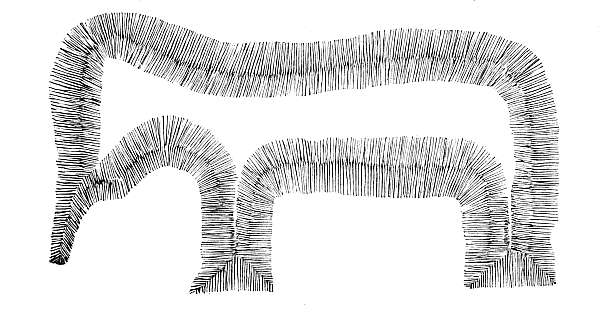
Fig. 4. —Elephant Mound (Grant County, Wisconsin).
But to return to the carving, a somewhat novel feature in it, and one which has been objected to as casting a doubt upon its authenticity, is the spear between the two upright human figures on the right. Large flint spear-points, so-called, are found abundantly in the Eastern States, and within the last hundred years instances of the use of the spear by the Indians in hunting and fishing are common; no one doubts, as we learn, for instance, in Tanner's narrative, that the Indians speared salmon in the Eastern rivers, or, as Catlin shows, used steel-pointed lances in their Western buffalo hunts. Yet the early writers, in their descriptions of aboriginal implements, have been supposed to make no mention of the spear, and there has been some controversy among archæologists as to whether it can be classed among Indian prehistoric weapons of warfare or the chase. [Pg 24]
Dr. Abbott, who, in his "Prehistoric Industry," has given a wood-cut of the curious egg-shaped stone found at Lake Winnipissiogee, and upon which there are several carvings of spears, quotes in the same work, by way of the nearest approach to an allusion to the spear among the early writers, a description from Josselyn of an elk-hunt among the early Massachusetts Indians, in which the writer describes a lance made of a staff a yard and a half long and pointed with fish-bone. But a passage in Bernal Diaz del Castillo ("Historia verdadera de la Conquista de la nueva Espana," Madrid, 1638), kindly pointed out to the writer by Dr. Rau, seems to furnish conclusive evidence on the subject. Bernal Diaz, among several instances in his works, speaks (chapter vi.) of an attack upon the Spaniards in Florida by Indians "armed with immense-sized bows, sharp arrows, and spears, among which some were shaped like swords" ("y lanzas y unas ā manera de espadas").
Furthermore there is fig. 5 (plate xiv. from De Bry's "Brevis Narratio," published in Latin in Frankfort-on-the-Main in 1591), representing Indians holding spears, for which likewise the writer is indebted to Dr. Rau. It was drawn from life by one Jacques Le Moyne, a French artist, in 1564. He had come to Florida with the French Admiral Laudonnière, and having been left by the expedition for some months at a fort upon the St. John's River, frequently made sketching expeditions among the neighboring tribes. Many similar drawings by him of warriors armed with spears are to be found among the numerous illustrations in De Bry. [Pg 25]
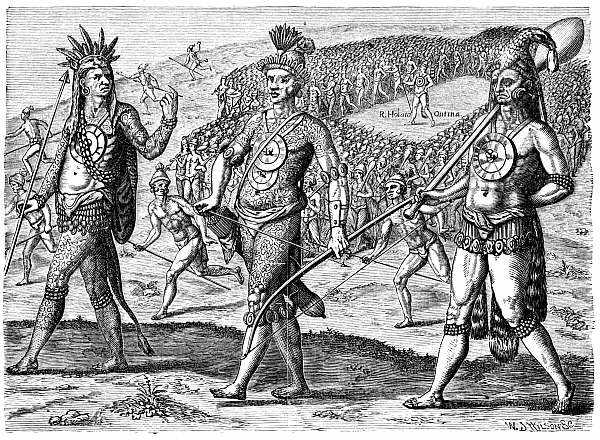
Fig. 5.—Picture of North American Indians carrying spears, drawn from life by Jacques Le Moyne, in 1564.
[Pg 26] Passing over the mysterious animal on one of the Davenport tablets, sometimes taken for a mammoth, and the pictograph on a boulder near the Gila River seen by Colonel W. H. Emory in 1846 in a military reconnaissance,[F] and which, he says, "may with some stretch of the imagination be supposed to be a mastodon," we come to the supposed traces of the elephant noticed by numerous writers in the mural paintings and architecture of Mexico and Central America.
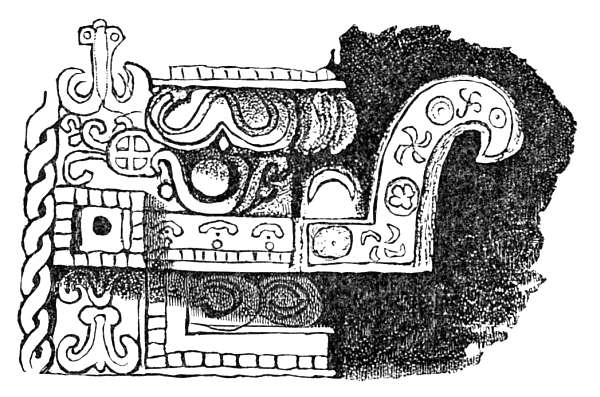
Fig. 6.—Elephant Trunk (Uxmal).
Figures 6 and 7, reduced from Catherwood's "Atlas" to Stephens' "Yucatan," are fair specimens of the remarkable architectural ornaments from Central America known as elephant trunks, and which, placed between two eyes and a mouth-like cavity, seem at first, as Waldeck and other travellers have remarked, to bear a striking resemblance to the trunk of a proboscidean. [Pg 27]
Figure 6 is from the gateway of the great Teocallis at Uxmal, and 7 from that of the Casa de las Monjos at Uxmal; as in the case of all the other "elephant trunks," however, they offer no suggestion of the prominent tusks of the American elephant, and, as Dr. F. W. Putnam maintains, should perhaps be looked upon as grotesque representations of the human race, of which the so-called trunk forms the nose.
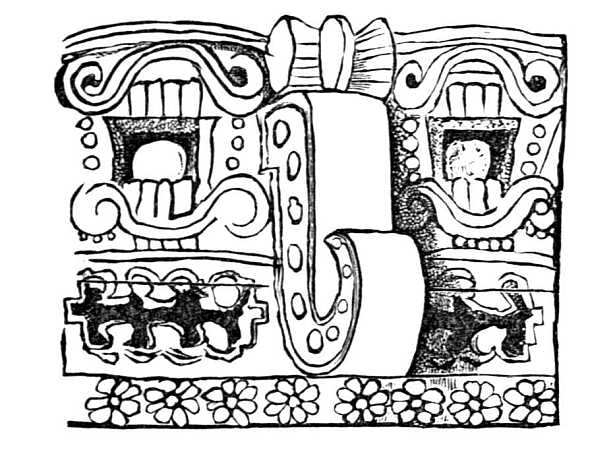
Fig. 7.—Elephant Trunk (Uxmal).
Far more striking among the so-called traces of the elephant in North America are the priests' head-dresses from Mexico and Yucatan.
Figure 8, a reduction from plate xiii. in Waldeck's "Recherches sur les Ruines de Palenque," is taken from a stucco bas-relief in the palace of Palenque. Waldeck considers it "evidently a representation of the head of a proboscidean."
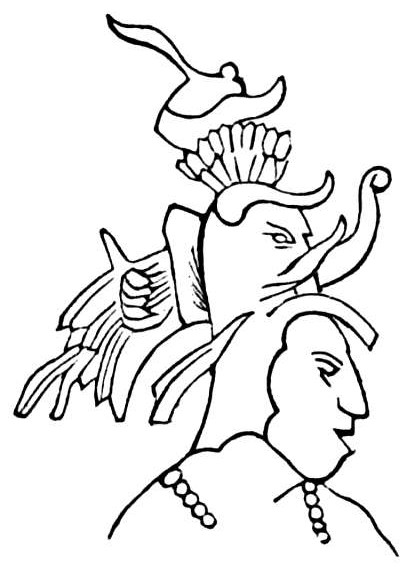
Fig. 8.—Elephant Head-dress (Palenque).
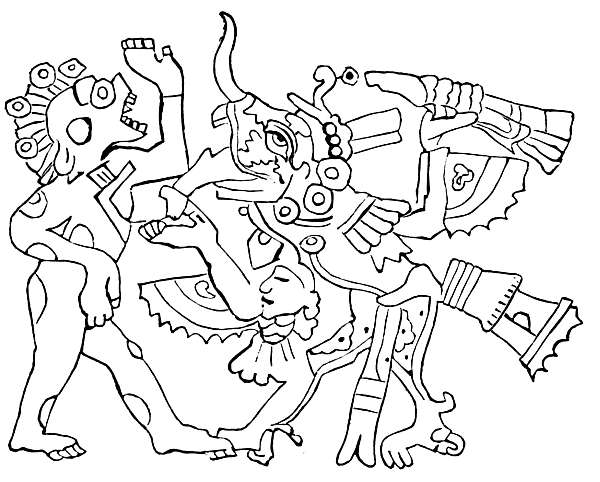
Fig. 9.—Elephant Head-dress (Mexico).
Figure 9, the no less fantastic Mexican head-dress, is from the Vues des Cordilleras, plate xv. As to it, Humboldt says: "I would not have had this hideous scene engraved, were it not for the remarkable and apparently [Pg 28] not accidental resemblance of the priest's head-dress to the Hindoo Ganesa, or elephant-headed god of wisdom. It seems hardly possible to suppose that a tapir's snout could have suggested the trunk in the head-dress, and we are almost left to infer either that the people of Atzlan had received some notice of the elephant from Asia, or that their traditions reached back to the time of the American elephant." [Pg 29]
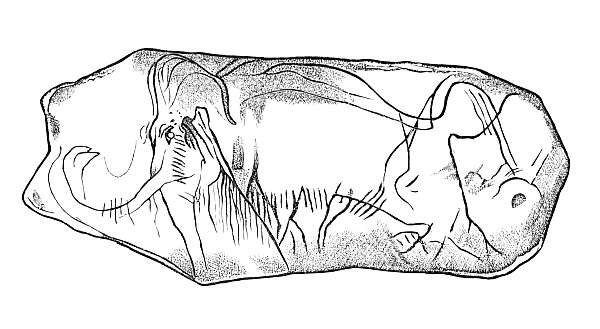
Fig. 10.—Prehistoric carving of the Mammoth from the cave of La Madeleine.
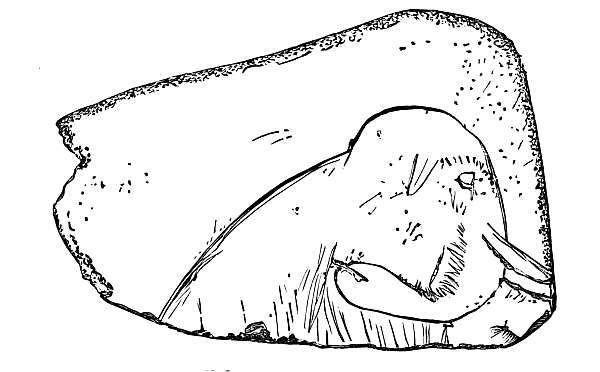
Fig. 11.—Mammoth Carving from the Collection of M. Lartet.
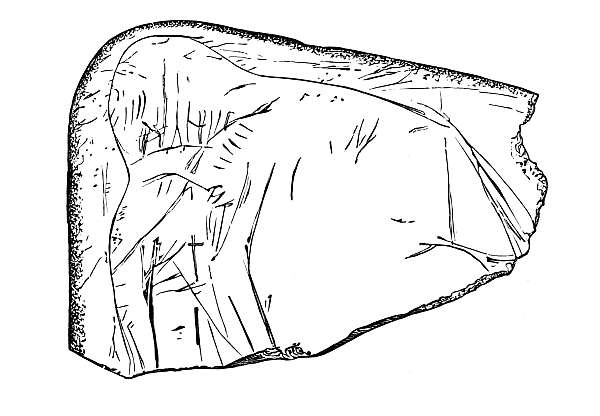
Fig. 12.—Mammoth Carving from the Collection of M. Lartet.
It is interesting to compare the Lenape Stone with the mammoth carvings of the cave-men of Europe, of which we here give the series. None of these outlines equal the Lenape drawing in realistic spirit except, perhaps (fig. 10) the most remarkable of them all, the celebrated La Madeleine carving. It is engraved upon mammoth ivory and was discovered in 1864 in the cave of La Madeleine, Perigord, France, by M. Louis Lartet. It was broken into [Pg 30] five fragments, and like the carving on the Lenape Stone, which it singularly resembles in general position, and in the indecisive drawing of the back and tail, unmistakably represents the mammoth. The mammoth scratching his side (fig. 11), and the very indistinct head (fig. 12), carved [Pg 31] on opposite sides of a bone plate, are from the Edouard Lartet collection. M. Louis Lartet, brother of the former, in his description of the drawings in the "Matériaux pour l'histoire primitive de l'homme," vol. ix., p. 33, thinks that "the primitive artist to whom these rude but sufficiently faithful representations are due, and who changed his mind several times when sketching, had, without doubt, the living model before his eyes, and was disturbed in his work by the movements of the animal."
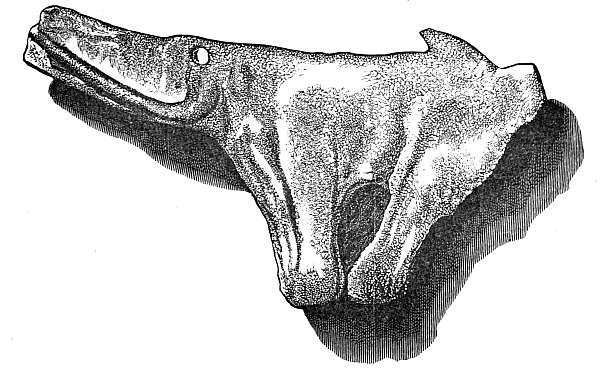
Fig. 13.—Mammoth Dagger-hilt from the Rock Shelter of Bruniquel.
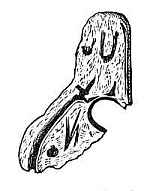
Fig. 14.—
Head of Mammoth
from the cave of
Laugerie Basse.
Figure 13, is the mammoth dagger-hilt carved in deer horn, in the collection of M. Peccadeau de l'Isle. It was discovered in the rock shelter of Bruniquel (Tarne et Garonne), France. Here, to avoid breakage probably, the [Pg 32] muzzle has been greatly exaggerated and the shape of the trunk and position of the tusks have been considerably departed from.
The least interesting specimen perhaps in the French collection is (fig. 14) the very indistinct elephant's head, minus the tusks, discovered by the Marquis de Vibraye in the cave of Laugerie Basse, Dordogne, France. Another so-called prehistoric representation of the mammoth, though resembling that animal only in the trunk-like prolongation of its muzzle, is (fig. 15) a more modern bronze specimen from Siberia. The writer of the description in the "Matériaux," vol. iv., p. 197, prefers to consider it a fantastic cat, tiger, or lion. [Pg 33]
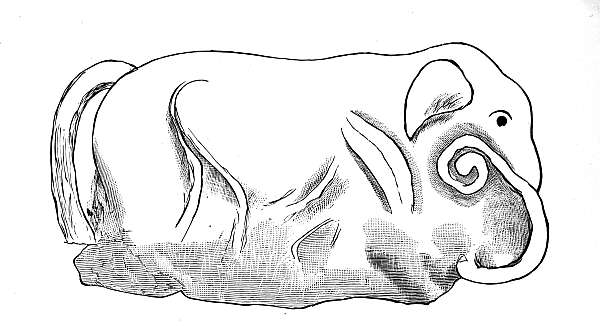
Fig. 15.—Bronze figure supposed to represent the Mammoth. (Siberia.)
Let us picture to ourselves, as it occurred in ancient times, and when his customs and traditions were as yet uncontaminated by civilization, one of the great religious feasts of the Indian—a dance, in honor, perhaps, of the sun, or pipe of peace, or of the green corn.
A wildly picturesque scene rises before us, as we read the descriptions of writers who have witnessed these ceremonies in later days; such a scene, as—in the language of Catlin: "not all the years allotted to mortal man could in the least deface or obliterate from the memory."
The tribe is assembled in the Indian village, or upon a bare hill-top, or perhaps in a lonely spot in the forest; a great bonfire burns in their midst, around which many mysterious rites have been performed. The rain perhaps was to be called down from heaven, sickness averted, evil spirits to be exorcised and driven away, or the deer or moose to be led in a state of charmed fatuity into the midst of the camp. With wild noises and gestures the warriors have danced around the fire, waving corn-stalks, or fiercely brandishing their weapons of war; the odor of burning tobacco or roasting dog's flesh fills the air, and the forest re-echoes with the cawings of the crow, the [Pg 35] "gobble" of the wild turkey, or the growl of the bear, exactly imitated by the dancers. With a truthfulness born of their intense sympathy for nature, the moving figures mimic the spring of the panther or wild-cat, the start of the deer, and the sinuous motion of the snake.
At length a figure, half man half animal, approaches—the prophet or medicine-man. Nothing can be more strange than his appearance; his dress is hung with the skins of snakes, frogs, and bats, and adorned with the beaks, tails, and toes of birds, and the hoofs of the deer and antelope,—a diabolical embodiment of animal monstrosity.
All is now quiet, and from his medicine bag, made of the skin of the raccoon, polecat, or bat, beautifully decorated, and lined with moss and fine grass, he produces a scroll of birch bark, a tablet of wood, or a stone, engraved with mystic characters. Holding the tablet in his hands, as his eye falls upon the carved devices a low sound, rising into [Pg 36] a song or chant, now only interrupted by the crackling of the fire, issues from under the hideous bear's-mask which hides his head. Each picture suggests to his mind some event of the far past, carefully treasured in the traditional lore of his tribe.[G] His song, rising and falling in strange inflections, and preserving a sort of rhythm, now tells of the creation of the world, a deluge, the origin of his people, and their primitive struggles with the forces of nature; now images of primeval giants and demi-gods rise before the minds of the assembled tribe, his hearers, of Manabozho the great hare, of Tarentya-wagon holder of the heavens, of Hiawatha, and Nanabush, and of "Stonish Giants," and "Flying Heads"; now he tells of the passage of great waters and mountains, of treeless plains, and forests, now of long wars with human enemies, and of the final coming of the whites. The squatting figures listen in motionless silence, as the song proceeds through its many verses, each the theme of a particular event. At last it ceases, and the pictured scroll or tablet, formula of its spell, restored to its place in the medicine pouch, remains hidden from the eyes of the tribe until its reappearance upon some similar occasion.
Such is the song-chronicle of the Indian's history; and such songs are known to have been carefully preserved and sung by many if not all of the Eastern tribes.
Such was the national song-legend of the Creeks and Choctaws, narrating in considerable detail their traditional [Pg 37] origin and early migration from the West. It was read to the English by the Creek chief, Chekillè, at Savannah, in 1775, "and was written in red and black characters on the skin of a young buffalo." This pictured skin, with an English translation, was sent to London, and there, in a frame in the Georgia office, at Westminister, was kept for many years as a curiosity; it was finally lost, but the translation has been recently brought to light by Dr. D. G. Brinton, of Philadelphia.
Such, too, was the national song of the Cherokees, sung by them at their annual green-corn dance. Portions of it which tell of an early migration from the headwaters of the Monongahela, and of the great mound at Grave Creek which the Cherokees claim to have built, are given by Haywood in his "History of Tennessee." They were related to the author from memory by an old Indian trader who had heard the song. Mr. Chamberlain, at present missionary among the Cherokees, states that Guess or Sequoyah, a half-breed Cherokee, since dead, had invented the Cherokee alphabet of eighty-two letters, for the express purpose of perpetuating this chronicle of his nation, and had recorded it in the new characters, but these interesting manuscripts, which after his death were unfortunately mislaid, have thus far escaped discovery.
The Blackfeet, too, have a singular historical song sung on stated occasions; and the Shawnees, now situated in the northeast corner of the Indian territory, have a [Pg 38] national legend, described in one of the late Indian reports as a "weird song sung in a rising melancholy strain"; it is sung at one of their great annual feasts, but as yet the double-barrelled shotgun or the "handsomest blanket in Philadelphia," offered by Dr. Brinton for a translation, have not served to break the reserve of the Indians familiar with the particular dialect in which it is sung, and who say that its revelation would bring misfortune upon the tribe.
The historical records of the Ojibways, says Ka-ge-ga-gah-bowh, or George Copway, their native historian, were written in Indian hieroglyphics upon "slate-rock, copper, lead, and the bark of birch trees," and kept in three secret underground depositories near the headwaters of Lake Superior, where, being disinterred and examined every fifteen years by a committee of chiefs, the dimmed and decaying pictographs were replaced by facsimiles.
It seems highly probable, in fact, that the solemn songs above, as well as most of the important historical narratives of the Indian tribes, have been repeatedly and variously recorded in eye-catching pictures of men, animals, and natural objects, intended to refresh or jog the memory of the singer or speaker, in his lengthy recitations to the assembled tribe. And such a pictured song-chart, or reference-table we may perhaps consider the carving on the reverse of the Lenape stone (fig. 16), which, should it be, as we have supposed, a production of the [Pg 39] Lenni Lenape, would not unnaturally refer to the well-known historical legend of that ancient people.
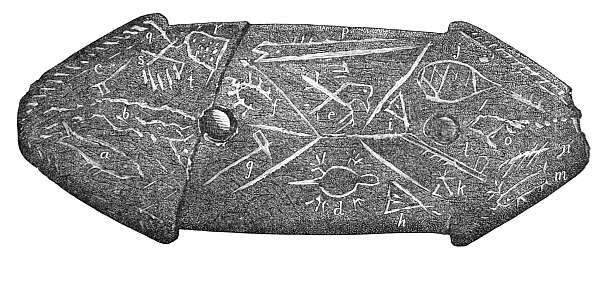
Fig. 16.
This tradition of the Delawares, more interesting and suggestive probably than any of these long-overlooked records of ancient North America, has once at least, been recorded by Indians in pictographic symbols; fortunately it has been preserved to us in full, and we can compare it with the carving on the reverse of the Lenape stone (fig. 16), which we may suppose suggested to the mind of the Indian singer versed in the art of picture-writing some at least of the events remembered in his tradition.
Two versions of this wonderful Indian chronicle have been rescued from oblivion. The first, far less complete than the other, was collected from the Indians themselves by the Moravian missionary Heckewelder, about 1800. It reads as follows: "The Lenni Lenape (according to the traditions handed down to them by their ancestors) resided many hundred years ago in a very distant country, in the western part of the American continent. For some reason which I do not find accounted for, they determined on migrating to the eastward, and accordingly set out together in a body. After a very long journey, and many nights' encampments by the way, they at length arrived at the Namaesi Sipu, or River of Fish (from namaes, a fish, and sipu, a river)."
One of the first figures that catches our eye on looking at the carvings is the unmistakable outline of a fish, (a), just beneath the waving lines; (b) representing [Pg 40] water at the left of the stone. The tradition goes on to say that at this river the Delawares "fell in with the Mengwe (Iroquois, or five nations), who had likewise emigrated from a distant country, and had struck upon this river somewhat higher up. Their object was the same with that of the Delawares; they were proceeding on to the eastward until they should find a country that pleased them. The spies which the Lenape had sent forward for the purpose of reconnoitring, had long before their arrival discovered that the country east of the Mississippi was inhabited by a very powerful nation, who had many large towns built on the great rivers flowing through their land. Those people (as I was told) called themselves Talligeu or Talligewi. Colonel John Gibson, however, a gentleman who has a thorough knowledge of the Indians, and speaks several of their languages, is of opinion that they were not called Talligewi, but Alligewi, and it would seem that he is right, from the traces of their name, which still remain in the country, the Allegheny river and mountains having indubitably been named after them. The Delawares still call the former Alligéwi Sipu, the River of the Alligewi."
"Many wonderful things are told of this famous people. They are said to have been remarkably tall and stout, and there is a tradition that there were giants among them, people of a much larger size than the tallest of the Lenape. It is related that they had built to themselves regular fortifications or intrenchments, from whence they [Pg 41] would sally out, but were generally repulsed.[H] * * * When the Lenape arrived on the banks of the Mississippi, they sent a message to the Alligewi to request permission to settle themselves in their neighborhood. This was refused them, but they obtained leave to pass through the country and seek a settlement farther to the eastward."
This agreement, that the Lenape should cross in peace, might have been symbolized in the Muzzinabiks (rock writings) and historical song records of any tribe, by the figure of the pipe (c) on the left of the stone, just above the water, and opposite the fish.
"They accordingly began to cross the Namaesi Sipu," continues the account, "when the Alligewi, seeing that their numbers were so very great, and in fact they consisted of many thousands, made a furious attack on those who had crossed, threatening them all with destruction if they dared to persist in coming over to their side of the river. Fired at the treachery of these people, and the great loss of men they had sustained, and besides, not being prepared for a conflict, the Lenape consulted on what was to be done—whether to retreat in the best manner they could, or try their strength, and let the enemy see they were not cowards, but men, and too [Pg 42] highminded to suffer themselves to be driven off before they had made a trial of their strength, and were convinced that the enemy was too powerful for them. The Mengwe, who had hitherto been satisfied with being spectators from a distance, offered to join them on condition that, after conquering the country, they should be entitled to share it with them. Their proposal was accepted, and the resolution was taken by the two nations to conquer or die. Having thus united their forces, the Lenape and Mengwe declared war against the Alligewi, and great battles were fought, in which many warriors fell on both sides."
This ancient alliance may have been symbolized to the mind of the Delaware by the figures of the hawk (e), beneath which is seen (f) perhaps a wampum belt, and of the turtle (d) in the central part of the stone, and set in divisions formed by one intersecting and four diverging lines. Devices of the "great Thunder-bird, whose eyes were fire and glance lightning, and the motion of whose wings filled the air with thunder," and of the "great turtle, upon whose back the mother of the human race had been received from heaven," were common in the mystic songs of the medas or priests, and their particular significations in these incantations might have been almost endless when we consider that to the initiated Meda or Josakeed (prophet) the same sign calls up quite different ideas, as the theme of the writer varies from war to love, or from the chase to medicine, or prophecy. If, however, we refer the subject of the carving to history, the hawk and turtle may well be viewed as the tokens or heraldic [Pg 43] badges of the chief actors in the story[I] (the Lenape and Mengwe).
As clan badges, both symbols were in common use among most of the Indian tribes. The turtle clan, says Heckewelder, was the governing family in any nation, and among the Delawares claimed an ascendency over the wolf and turkey families on account of its superior antiquity and relationship to "the great turtle, the Atlas of their mythology, who bore the great island—the earth—upon its back."
The hawk totem, which of course the Delawares might have applied to any people they chose, irrespective of its real emblem, occurred among the Hurons, and in both the Seneca and Cayuga tribes of the Iroquois confederacy; also among the Ojibways, Pottowatamies, Miamis, Abenakis, Sacs, and Foxes, and in many other tribes.
The account goes on to say that "the enemy fortified their large towns and erected fortifications, especially on large rivers and near lakes, where they were successively attacked and sometimes stormed by the allies. An engagement took place, in which hundreds fell, who were afterwards buried in holes or laid together in heaps and covered over with earth. No quarter was given, so that the Alligewi, at last, finding that their destruction was inevitable if they persisted in their obstinacy, abandoned the country to the conquerors and fled down the Mississippi River, from whence they never returned. The war [Pg 44] which was carried on by this nation lasted many years, during which the Lenape lost a great number of their warriors, while the Mengwe would always hang back in the rear, leaving them to face the enemy."
In this description of a superior race of Indians, conquered after a most desperate resistance, and whose memory still survives in the great mountain chain to which they have given a name, we find a key to the often-spoken-of mystery of the mound-builders and their sudden disappearance.
The story of their long death-struggle and final overthrow by a horde of savage invaders, as here given in the formal style of Heckewelder, seems somewhat colored by his well-known partiality for the Delawares. It is confirmed, as we shall see, by the evidence of other Indian traditions and the study of their language, which seems to show that this people,—the Alligewi or mound-builders—fleeing down the Mississippi, were received and adopted by the Choctaws and Cherokees, themselves in comparatively recent times a mound-building people, and who thus have become in part their descendants.
A suggestion of these long and bloody wars, in which the Lenape did most of the fighting, may be seen in the figure of the tomahawk (g) just below the turtle,[J] and of the mound-builders themselves perhaps, in the singular [Pg 45] group of figures above the water on the left, i. e., the outline of a mountain or mound on which a series of numerical marks are faintly seen, a tablet inscribed with ten dots, two diagonally intersecting lines, and five parallel marks or points.
"In the end," continues the account, "the conquerors divided the country between themselves," as the wigwams (h and i) above each totem might denote. "The Mengwe made choice of the lands in the vicinity of the great lakes" and on their tributary streams, again suggested, perhaps, by the snow-shoe (j) "and the Lenape took possession of the country to the south. For a long period of time—some say many hundred years—the two nations resided peacefully in this country and increased very fast. Some of their most enterprising huntsmen and warriors crossed the great swamps, and falling on streams running to the eastward, followed them down to the great Bay River (Susquehannah), and thence into the bay itself, which we call Chesapeak." As they pursued their travels, partly by land and partly by water, in this primitive reconnaissance of the great wilderness now our homes, journeying sometimes near and at other times on the "great salt-water lake" (the sea), they finally discovered the river which we call the Delaware.
"Thence exploring still eastward," continues the account, "they discovered the Scheyichbi country, now named New Jersey, and at length arrived at another great stream—that [Pg 46] which we call the Hudson or North River. Satisfied with what they had seen, they (or some of them), after a long absence, returned to their nation and reported the discoveries they had made. They described the country they had discovered as abounding in game and various kinds of fruits, and the rivers and bays with fish, tortoises, etc., together with abundance of water-fowl, and no enemy to be dreaded. They considered the event as a fortunate one for them, and concluding this to be the country destined for them by the Great Spirit, they began to emigrate thither, as yet but in small bodies, so as not to be straitened for want of provisions by the way, some even laying by for a whole year. At last they settled on the four great rivers (which we call Delaware, Hudson, Susquehanna, and Potomac), making the Delaware, to which they gave the name of 'Lenapewihittuck,' (the river or stream of the Lenape), the centre of their possessions."
Here the ancient portion of the chronicle and its parallelism with the figures on the stone seems to end, the remainder being devoted to long wars with the Mengwe, relations with the whites, and the more modern events of the history of the tribe in the east.
The other figures upon the stone—the star (k), the calumet (l), the deer (m), the curve crossed by three oblique lines (n), probably a war canoe, and the fish-like figure (o) at the end of the stone—are hardly suggested by the narrative, yet may refer to further details of the passage of the Alleghenies, and the exploration and settlement [Pg 47] of the country to the east, along the great rivers and by the sea-coast.
Far more interesting than Heckewelder's account, is a full version of the great national song of the Lenape as they sung it in their own language, with an English translation, and with all the pictographic devices used to jog the memory of the singer. He may well have needed them, as the whole song consists of two hundred and two verses. It was first published in 1836 by the eccentric French-American philosopher, Rafinesque, in an extravagant work by him entitled "The American Nations," and is known as the Wallum Olum (literally, painted sticks), or pictographic traditions of the Lenni Lenape. It contains the Delaware account of the creation, a deluge, the early migrations and entire history of the tribe, and one hundred and eighty-four mnemonic symbols painted upon tablets of wood. "It was obtained" says Rafinesque, "about 1822,—the symbols from a Dr. Ward of Indiana, who had received them as a reward for a medical cure from the Delawares, at Wahapani or White River, in 1820, and the verses from another individual."
Mr. E. G. Squier, who considered the internal evidence furnished by the songs sufficiently strong to settle their authenticity, submitted the manuscript copy of the songs and pictographs in the hand of Rafinesque, who it appears had never owned the original "painted sticks," to George Copway, the Chippewa chief, who unhesitatingly, he says, pronounced it authentic. This manuscript, together with [Pg 48] the pictographs, of which Rafinesque had published none, and Squier but forty, was considered hopelessly lost until its fortunate discovery a few weeks ago by Dr. Brinton, by whom it will shortly be published with a new translation.
Passing over its account of the creation and deluge, the narrative goes on to describe the passage by the Lenape of a large body of water on the ice (Behring's Straits, says Rafinesque), and their settlement at a place called Shinaki, or the "Land of Firs."
After many generations of chiefs, continues the fourth song, during which time they were continually engaged in wars with "Snakes" (enemies), they wander from the fir land to the south and east, pass over a hollow mountain Oligonunk (Oregon, according to Rafinesque), and at last "find food" at "Shililaking, the plains of the Buffalo Land." Here they tarry and build towns and raise corn on the great meadows of the Wisawana (Yellow River). But after many wars with "Snakes," "northern enemies," and "father snakes," of which we can see a suggestion in the eel-like form (p) on the stone, they again resume their migration towards the "sun-rising," and finally reach the shores of the Messussipu,[K] or Great River, "which divides the land." The accompanying pictograph for verse 49, [Pg 49] descriptive of the Great River, quite unlike the figure upon the stone, is here given from the original drawing by Rafinesque, kindly furnished the writer by Dr. Brinton (fig. 17). The narrative, of which we give the English translation by Rafinesque, omitting the Delaware version, continues in the original as follows:
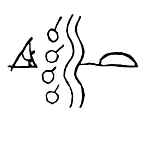
Fig. 17.
49. The Great River (Messussipu) divided the land, and being tired, they tarried there.
50. Yagawanend (Hut-maker) was next sakima, and then the Tallegwi were found possessing the east.
51. Followed Chitanitis (Strong-friend), who longed for the rich east-land.
52. Some went to the east, but the Tallegwi killed a portion.
53. Then all of one mind exclaimed: War, war!
54. The Talamatan (not of themselves) and the Nitilowan all go united (to the war).
55. Kinehepend (Sharp-looking) was their leader, and they went over the river.
56. And they took all that was there, and despoiled and slew the Tallegwi.
57. Piniokhasuwi (Stirring-about) was next chief, and then the Tallegwi were much too strong.
58. Teuchekensit (Open-path) followed, and many towns were given up to him.
59. Paganchihilla was chief, and the Tallegwi all went southward.
60. Hattanwulaton (the Possessor) was sakima, and all the people were pleased.
61. South of the lakes they settled their council-fire, and north of the lakes were their friends the Talamatan (Hurons?).
Nothing could be more interesting to the lover of American archæology than a study of this song—with the single exception perhaps of the Lenape stone, the most remarkable Indian document in existence. The latter part of the story here given, is even less suggestive than the preceding portions, which we have been obliged to omit.
The generations of chiefs, which it recites in order, seem to include thousands of years, and as we read its account of a creation and a deluge, of the passage of a great water upon the ice, and an arrival at a "Land of Firs," we almost pardon the extravagant speculations of Rafinesque, to which it gave rise.
Both versions of the account tell the same story, yet there is one striking difference between them. In the Heckewelder version the allies of the Lenape are spoken of as "Mengwi" (Iroquois, Mingoes); in the Wallum Olum as "Talamatan" (Hurons, called Delamattenos by the Delawares); but the variance is reconciled when we consider that in ancient times, as their language and traditions prove, the Hurons and Iroquois were one closely allied nation, constituting one family or linguistic stock. [Pg 51]
We may doubt, however, whether the great river crossed in the migration—"Namaesi Sipu" (Fish River) in Heckewelder, and "Messussipu" in the Wallum Olum—referred to the Mississippi.
The Huron-Iroquois will tell us, when questioned, that at an early period, and while the families were still united, his people, coming originally from the northeast of Canada, migrated to the southward, and had not come from the west across the Mississippi; he too has traditions of crossing a river and attacking a race of mound-builders, but the river of his account was crossed to the southward, and lay on the north of the mound-builders' country. The Iroquois tradition is given in a famous passage, supposed to refer to the mound-builders, in the account of David Cusic, a native Iroquois, of the Tuscarora clan, who wrote a history of his tribe. We give it here in the original, uncorrected form, as published by Schoolcraft.
Referring to an early age of monsters, demi-gods, giants, and horned serpents, when the Hurons and Iroquois were as yet but one people, and they and other tribes, "the northern nations," possessed the banks of the great lakes, "where there were plenty of beavers," but "where the hunters were often opposed by the big Snakes," Cusic goes on to say that "on one occasion the northern nations formed a confederacy, and seated a great council-fire on the river St. Lawrence. Perhaps about 2,200 years before the Columbus discovered the America, the northern nations appointed a prince, and immediately repaired to the south and visited the Great Emperor, who resided at [Pg 52] the Golden City, a capital of the vast Empire. After a time the Emperor built many forts throughout his dominions, and almost penetrated the Lake Erie. This produced an excitement; the people on the north felt that they would soon be deprived of the country on the south side of the great lakes. They determined to defend their country against any infringement of foreign people; long, bloody wars ensued, which lasted about one hundred years. The people of the north were too skilful in the use of bows and arrows, and could endure hardships which proved fatal to a foreign people; at last the northern nations gained the conquest, and all the towns and forts were totally destroyed, and left them in the heap of ruins."
It has been supposed that the upper St. Lawrence or Detroit River, streams noticed by the Indians as abounding in fish, was the "Fish River" of the Heckewelder tradition. Here, as we have seen according to information collected from the Lenni Lenape, desperate battles had taken place with the Allegwi, hundreds of whom were slain and buried under mounds in that vicinity.[L]
Other considerations, too, induce us to suppose that the Lenape and Huron-Iroquois invasion came from the northward and not from the west. If we study the shape and position of the mounds themselves along the southern shore of the great lakes, we find that they present often the appearance of fortifications erected against the advance [Pg 53] of an enemy from the north, and suddenly abandoned after a long struggle. Also the scattered implements and half-removed blocks of ore found in the prehistoric copper mines on the south shore of Lake Superior, seemed to indicate their hasty desertion by the miners upon the sudden inroad of an enemy from that direction.
Again, the works of the mound-builders, though at some points insignificant and hardly perceptible, extend considerably west of the Mississippi, and probably would have been encountered by the advancing Lenape before reaching that river, and had it been the stream meant it would not have been spoken of as the boundary of the mound-builders' empire.[M] [Pg 54]
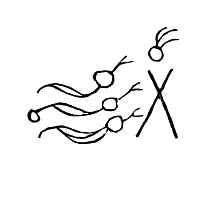
Fig. 18.
The Wallum Olum, however, with its hieroglyphics, does not end with the brief extract given. Song five, consisting of fifty-eight verses, recounts the details of the occupation by the conquerors of the Ohio valley, and long wars with enemies denominated "Father Snakes," "Stone Snakes," and "North Snakes," whose pictograph in the original manuscript is here given (fig. 18). They pass the Alleghenies, and exploring the Chesapeake Bay and great rivers of "the large and long east land," finally establish themselves on the Delaware, making "Maskekitong," the rapids at Trenton, the centre of their dominions. We have now reached the time of the coming of the whites, and the last verses of the song speak in brief simplicity of a people who came from somewhere, "and that which was white" (ships) "coming from the East Sea."
There is still another song—the sixth—continuing the chronicle and recounting the melancholy story of the Lenape's contact with the whites, and final westward journey to Ohio, where the records were obtained. A narrative of sufferings and hard wrongs, whose recital by the Indian had caused Heckewelder, as he said, "to feel ashamed that he was a white man."
The symbols appended to the songs, and among which the forms of the rectangle and circle frequently occur, end with the fifth song; they appear very arbitrary, and it is certainly disappointing to find that they bear no [Pg 55] resemblance to the carvings upon the Lenape stone, likewise, as we have supposed, productions of the Lenni Lenape and dealing with the same subject. Yet we need not be surprised when we consider the varied and often arbitrary methods of Indian picture-writing.
In comparing the carvings on the reverse of the Lenape stone with the Lenape and Huron-Iroquois traditions of their early migration and struggle with the mound-builders, we have spoken only of probabilities. Possibly these carvings may refer to the incantations of the prophets and doctors, to songs for "medicine hunting," or charms against evil spirits, and not to the history of the tribe, as recounted in the Wallum Olum and the narratives of Heckewelder and Cusic. Possibly, too, the modern Indians who have seen the carvings may have entirely mistaken their subject, as similar signs are used in quite different kinds of their picture-writing. Yet if we view the chief feature of the Lenape stone—the mammoth picture—as an example of muzzinabik or historical picture-writing, an attempt to explain the carvings on the reverse of the stone as specimens of the same class of writings does not seem extravagant. Viewed in the light of these legends, and compared with the fragments of ancient Indian history which chance has preserved to us, the carvings upon the Lenape stone vividly impress upon our minds the reality of that dark period of our continent's past, antecedent to the first coming of the white man, separated from us by but a few centuries, yet [Pg 56] where the boundary line between history and geology becomes indistinct, when for hundreds, perhaps thousands, of years the Indian lived alone on the "great island," and while those deep-rooted peculiarities of his character, which civilization has failed to eradicate, were slowly growing out of his wilderness life.
The ancient presence of the Lenape is often remembered in the heart of his former dominions. Along the shores of the beautiful river, whose transatlantic name, applied also to his tribe, he resented, the arrow-head and tomahawk, everywhere found upon sites of ancient camps and fishing-grounds, tell of the long centuries of his possession. His memory lingers in the name and poetry of our Indian summer; and in that most delightful of autumnal seasons, when a warm wind blowing from the abode of the Great Spirit stirs the fields of ripened maize, we may see, where first the Indian's fancy must have seen it, a suggestion of his head-dress of feathers in the graceful motion of the corn-stalks. He is immortalized in richly melodious names of rivers, streams, and mountains, and his memory is forever recalled in the yearly growth of that noblest of American plants, the Indian corn.
In concluding here our view of the less distinct though not improbable reference of the carvings on the reverse of the Lenape stone to the ancient historical traditions of the Delawares, a brief review of the subject of the foregoing pages may not be out of place. [Pg 57]
We have seen that the stone was found at a spot situated in the ancient territory of the Delawares, and where many articles of undoubted Indian workmanship have been found,—among them two carved stones,[N] —that similar aboriginal carvings of the hairy mammoth have been discovered in Europe, and that a race of men, relics of whom have been found on the Delaware river and in California, and who may or may not have been the ancestors of the modern Indian, have existed in North America at the time of the mammoth. Moreover, that as yet nothing is definitely known as to the antiquity of the Indians' occupancy of our continent, and that there is no geological evidence to prove that the mammoth did not survive in America to a comparatively recent period. We have seen further that the Indians in several of their traditions attribute the mammoth bones seen by them on the Ohio to a great monster who was destroyed by lightning, and that there is a similarity too strong to be accidental between the Lenape tradition of the great Buffalo and the carving on the stone; finally, we may see perhaps a reference in the carvings on the reverse of the stone to the early Delaware traditions of their migration to the eastward and wars with the mound-builders, as detailed in Heckewelder's account, the "Wallum Olum," and David Cusic's history.
On the writer's second visit to Hansell, the latter was at his father's farm. He stated that the photographs shown him were representations of the stone, and said that he considered that he had been cheated. He had had no idea of the stone's value, and declared that it was a "mean trick," the purchase of all his relics—the stone included—for $2.50. When it was explained to him that Mr. Paxon, the purchaser, had been as ignorant as he in the matter at the time, he seemed satisfied.
On the third visit, February 10th, Hansell said:
I am sure that I found the large piece first, in the spring of 1872 (the year after my father bought the place—1871), and while "ploughing for oats" in the "corner" field, and near the corner where the by-road joins the Durham road—the roots of the last year's corn crop had shortly before been harrowed out. It was in April. When I saw it, it was lying on the top of the ground, a little to one side of the furrow. I stopped and picked it up; it seemed like "something different" from what I had ever found before. It was dirty—dirt stuck to the stone; by rubbing, I could see lines—"queer marks" over it. (When I afterward saw it at Mr. Paxon's, the latter had "cleaned it.") [Pg 62]
I am certain I saw an animal like an elephant on it before Mr. Paxon saw the stone. I carried it around a day or two in my pocket, and then put it in a box along with the other things; and whatever arrow-heads and other relics I found, I would put into the same box. The same day, I planted a corn-stalk into the ground to mark the place—a shower might wash out something else, I thought. I left the corn-stalk until the oats harvest, and then threw a stone there, but I soon came to know the place by heart. The box with the relics I kept locked up in my trunk, and I took care to keep it locked,—there were so many boys about. In the meantime, I was married. I showed the relics and stone to my wife, but she would not remember the elephant on the stone. I might have showed it to father, or might not, I am not sure. He would not remember. In the same field, I and others on the place found arrow-heads, coins (English and American pennies), and a part of a tomahawk or banner stone (sold to Mr. Paxon). I did not find any thing else in that field, but "gorget stones" without inscriptions, and round stone balls, with incisions on sides, were found near by.
In the spring of 1881, Mr. Paxon asked me whether I had any Indian relics. I said that I had. I told him I would be at home on Sunday, and he came the next Sunday afternoon—about May or June, as nearly as I can recollect,—1881. I brought out the box of relics, and told him that I would sell him the perfect arrow-heads for ten cents, and the broken ones for five cents apiece. I had a broken tomahawk and a piece of another, and I laid them and the stone aside, and said I thought I would keep them. But he did not take much interest in the rest, and said he wanted all the relics. He did not look much at the arrow-heads, but he picked up the stone and turned it around, and wet his thumb and rubbed it. He did not say any thing about the stone. I did not much want to sell him the stone, for I never saw any thing like it before. [Pg 63]
But he said he would take all the relics or none for $2.50. So I let him have them. At the same time he asked me whether I had not the other piece; perhaps I had, he said, and did not know it. I told him that I had not.
About a month after that time, he came by on foot and asked me whether I had found any thing more? I said that I had not. "If you do," he said, "keep it and give me the first chance."
I always had the other piece in my mind, and when I went in the field I used to look for it. I would walk around the spot in a circle, for I thought some one might have picked it up and then thrown it away again.
After we had cut the corn in the field, and as I went in to husk, I happened to pass near the place—I always remember the place,—I was thinking of the other piece, and was hardly in the field before I picked it up. I noticed the marks and the shape, and saw at once that it was the missing piece. It had notches around the edges. I put it in my pocket and laid it in the drawer. My wife never saw it. It was the little piece. I was married then and in my own house, and there was nobody about the house, so I did not lock it up.
This was in the fall—after the exhibition at Doylestown (October), in 1881. When I went down to Mr. Paxon's father's, Squire Paxon's, to pay my tax, on the 9th of November, 1881, I took this piece along. Young Mr. Paxon was not at home, but I waited till he came back. I said I had something "pretty nice" for him, and showed him the missing piece. He thought when he saw it that I would make him pay pretty dear for it, but I told him that I would give it to him. I had not rubbed or cleaned it. He put the pieces together and said "that is the missing piece." He took me up to his room and gave me some minerals. I advised him to glue the pieces together with "hickory cement." I had some of this cement at home, and offered to give it to him. [Pg 64]
The next spring I saw the stone again, all washed and cleaned. It did not look altered—only clean and rubbed off. I saw it again this February (1884), when you and Mr. Paxon came to see me, and I saw no change in it.
I never sold a relic before I sold those to Harry Paxon, and never knew any one from Philadelphia that took any interest in Indian relics. I used to give things away to relatives of mine, often boys—my cousins, when they came up from town. They had never seen any thing like an arrow-head before. I never gave a stone to any one but a relative. William Hansell, my brother, a little boy, saw me pick up the small piece of the Lenape Stone. I never heard of any one in this neighborhood interested in Indian relics before Mr. Paxon.
The first things that I remember giving away were a couple of black arrow-heads that I gave to James Aikens, in 1871. He lives in Germantown. This was before I found the stone.
Sworn to before
Benjamin S. Rich, J. P., Nov. 6, 1884.
The writer questioned Hansell's wife. She remembered his having shown her the relics before they were sold to Mr. Paxon, but had paid no attention to "these little stones he picks up," and did not remember whether "this stone you are talking about" was among them or not. The writer also questioned Hansell's father and mother. Neither had seen the stone. The boy, William Hansell, brother of Bernard, said that he had seen the little piece when Bernard picked it up, but had never seen the large piece of the stone. The piece he had seen was covered with dirt and mud, and had "half a hole" in it. Bernard had told him that he was going to give it to Mr. Paxon. [Pg 65]
I remember Hansell telling me of his Indian relics at my father's office. I went to see him on a Sunday, and he showed me, in the wood-shed, a tobacco-box half full of relics, among them the large piece of the Lenape Stone. At the time I never realized what it was. It was covered with dirt, as were all the relics. There must have been about two hundred arrow-heads, broken and perfect, besides a broken axe and fragments of a banner stone, and one or two large spears and so-called "gigs." The stone struck me as an extraordinary Indian relic. Buying the relics, I brought them home that Sunday afternoon, and at once showed them to my father. He saw the elephant. Whether I had noticed it before I cannot remember. Mr. John S. Ash saw this first piece—the large piece—before Capt. Bailey saw it. I showed it to any and everybody that came to my father's office, but can only be sure now of Mr. Ash. Capt. Bailey saw it and borrowed it while preparing his article. I had it at the Bucks County Bi-Centennial Exhibition, August 31, September 1 and 2, 1882. I did not particularly value the stone until I read Capt. Bailey's article. I cleaned out the soil which clung to the stone with a toothbrush, and may also have used a stick—but I think not a nail.
Sworn to before
Elias Eastburn, J. P., Nov. 8, 1884.
Young Hansell and his father were at my house on business (I am Justice of the Peace). They had rented a house. I think it was on a Saturday in '80 or '81, in the summer. The next day my son went to Hansell's and brought back a large number of Indian relics. He had invested two or three dollars in [Pg 66] them. In the lot was one of the pieces of the stone. I remember saying that it was a pity he had not the other half. The lines were not cleaned out. I recollect the elephant. He emptied the relics on the floor of the piazza. It was early summer, and warm weather—about May or June,—and I think on Sunday. I am certain of having seen the elephant the first day he got the stone. Bernard Hansell, I find in my book, paid his tax November 8, '81, but I am not positive in these dates to a day. There is not, and never has been, to my knowledge, any strange or suspicious person of an "archæological turn" in this neighborhood, and there is no one here clever enough to have made the stone.
Affirmed before
James Gilkyson, J. P., Nov. 8, 1884.
NOVEMBER 8, 1884.
At the time of my first seeing the Lenape Stone, I observed an elephant or mammoth carved upon the fragment. I cannot now fix the date of my first seeing this piece. Probably it was some three years since, though it may not be two and may be four. I think it was before the Bucks County Bi-Centennial Exhibition.
Affirmed before
Elias Eastburn, J. P., Nov. 8, 1884.
I saw the stone first, I think, in November, in the fall of 1881, and a few days after Mr. Paxon had obtained the second piece. He had said to me that he had a curious stone which he wished to show me. I remember his mentioning the figure of a turtle, a snake, and an elephant carved on the stone, although [Pg 67] he did not first mention the elephant figure or show that he appreciated the mammoth. It was not till he had read my article in the county newspaper that he came to know the value of the carving. He was only eighteen or nineteen then, and I believe would have sold the stone for a comparatively trifling sum. As soon as I took the stone home, after Mr. Paxon had lent it to me, all my family saw it. Judge Paxon, his uncle, did not realize its archæological importance, neither did Mr. Paxon, the owner's father. I showed it to Judge Paxon before I wrote the article. The first time Mr. Harry Paxon showed me the stone I remember his saying that "he could sell it for five dollars." He wanted me to glue or cement the pieces together, but I discountenanced the plan. I think he must have scraped out the original soil clinging to it with a nail or some sharp instrument, and I told him that he had cleaned the lines too much and that the stone had lost the look of age. The next time I saw it he had filled the lines with clay, and this I advised him to remove, as it did not resemble the soil of the original field. So the next time I saw it he had cleaned it again. I took the stone to the January or April meeting of the Bucks County Historical Society, 1882, and showed it to all the members present. I showed it to Gen. Davis, who advised me in connection with it to prepare an article on the Indian relics found in Bucks County, to be read before the July meeting at Penn's Manor. A few days after that I returned the stone to Mr. Paxon. Somewhere in June or July (1882) I borrowed it again, and kept it until two or three weeks after the meeting at Pennsbury. This meeting was on the third Tuesday in July, 1882. Mr. Paxon did not go to the meeting, but after reading my article in the paper he set a higher value on his relic and wished me to return it. I do not recollect seeing either part separately. The two pieces were together when I first saw it. I think Hansell told me that the large part had been found [Pg 68] first. Very many people saw the stone at my lecture at Penn's Manor. I had a large diagram of the inscription, several feet long. Two hundred people must have seen it. There was an article in the Bucks County Intelligencer about it, and it was at the Bi-Centennial and there seen by everybody.
Affirmed before
Elias Eastburn, J. P., Nov. 8, 1884.
Letter from Dr. D. G. Brinton, Professor of Archæology and Ethnology in the Academy of Natural Sciences, Philadelphia.
To the Editor of the Bucks County "Intelligencer":
The discussion in your paper about the so-called "Lenape Stone," in which my name has incidentally been introduced, leads me to address you a few lines on some archæological points, especially on the methods of distinguishing genuine from fabricated specimens. I shall only refer to the Lenape Stone by way of illustration. It was first shown to me by Professor Lewis, and after a careful inspection I pronounced it a modern piece of work, which opinion has been substantiated by later observers. My opinion was based, first, on the design, and secondly, on the execution. It may be laid down as a rule, holding good in all aboriginal designs of the Eastern United States, that no lines indicating either shading or rounding are found on figures of pure native origin. Every line was significant, and nothing was done for affect. Grouping was also unknown, and any such triple arrangement as the brute, the human, and the divine groups, standing in immediate relation to each other and forming parts of a picture, as appears on the Lenape Stone, was as far above aboriginal æsthetic conceptions as the Sistine Madonna would be above the execution of a sign-painter. Certain artistic details, as the [Pg 69] lightnings shooting in various directions from a central point (as from the hand of Jove), were also unknown to the art notions of the red race. The treatment of the sun as a face, with rays shooting from it, I also consider foreign to the pictography of the Delaware Indians, nor have I yet seen any specimens proved to be of their manufacture that present it. It is found, indeed, in Chippeway pictography, but there only in late examples.
The execution of such imitations also usually betrays their origin. The lines on the Lenape Stone are obviously cut with a metal instrument, making clean incisions, deepest in the centre and tapering to points—quite different from the scratch of a flint point. Shrewder fabricators than the unknown author of this one make use of flint points. Some of the Western "tablets" have been so inscribed. They may thus conceal their tools, but there are other resources for the archæologist. The surface of all stones undergoes a certain chemical change on exposure to the air, which is called by the French term patine. In many varieties, as flints, jasper, and hard shales, this affords a decisive means of discriminating a modern from an ancient inscription or arrow-head. It requires the use of the microscope and some practice, but with these most of such impostures can be detected. This does not exhaust the resources at the command of the antiquary to circumvent those who would practise on his love for relics of the past. But I have said enough to show that opinions on relics need neither be vague nor prejudiced. It is most desirable that the citizens of our Commonwealth should take an earnest interest in the collection of our aboriginal remains, and it is gratifying to learn that Bucks County is not behindhand in this direction.
From the Bucks County Intelligencer
of Sept. 6, 1884.
[Pg 70] Letter from Mr. H. Carvill Lewis, Professor of Mineralogy, Academy of Natural Sciences, Philadelphia.
Capt. J. S. Bailey:
Dear Sir:—Upon careful examination I am convinced that the mammoth on the Indian tablet is a forgery, being copied directly from the drawing of a mammoth on a piece of ivory found in the cave of La Madeleine, Perigord, France. The tablet is genuine, but the drawing upon it is recent.
Who do you think perpetrated this fraud?
Letter from Dr. F. W. Putnam, Curator of the Peabody Museum of Archæology, Cambridge, Mass.
Dear Mr. Mercer:
In answer to your request, I put on paper a few thoughts in relation to the carved gorget of slate said to have been found in Bucks Co., Penna. It is needless to say that I have examined the stone with great care; for if it is a work of prehistoric times in America, it is a specimen of very great archæological interest. The first impression I received was that it was probably a fraud. This was of course natural, after having seen several gorgets with figures carved upon them which were unquestionable frauds. I therefore first of all examined the stone, and was sorry to find that it had been so much cleaned, and rubbed, and scrubbed, and probably oiled, that no evidence could be derived from the character of the lines cut upon the surface of the stone, or from the stone itself, bearing upon its antiquity. So far as the testimony of the stone itself is concerned, the lines may have been cut within a few weeks [Pg 71] or many years ago. Throwing out of consideration all the facts you have given me in relation to the history of the stone as known to you, I am left with the character of the carvings alone upon which to draw conclusions. From a study of these I get the following results:
1st. The person who carved the stone must have been familiar with the appearance of an elephant or mammoth, either from having seen one or the other in life or represented in pictures. There is too much expression given to the details of outline of forehead, curve of back and belly, and position of the legs, representing the animal as walking, to be the work of one who only knew the animal from a general description handed down by tradition.
2d. Most of the other figures on both sides of the stone are of a character common to Indian picture-writing, but there are a few which, like the "mammoth," show an appreciation of details or ideas unlike any I can recall in Indian picture-writings. Take, for example, the fish on the edge of the small piece, and the long eel-like figure by the side of the bird—each of these have a few hair-lines drawn from the back as if to represent the rays of fins, in order to impress the character of a fish, although the rays are out of natural position. The figure of a man on his back under the foot of the "mammoth" is not drawn in the usual conventional manner, like the figure of the man with the bow.
3d. The idea of the heavens, conveyed by the figures of stars, moon, and sun, is probably not an unusual way of representing the sky or the heavens, but the mass of crossed lines near the sun, which are supposed to represent lightning, seems to me to be more the conventional symbol of the white man than the Indian.
Considering all these points I draw these conclusions:
1st. The carvings were made in ancient times by an Indian of superior artistic skill, who had seen a living mammoth, and [Pg 72] who wished to preserve some myth or tradition relating to the animal, in picture-writing upon his gorget; or,
2d. The carvings were made by an Indian in comparatively recent times, with the same idea of preserving a myth about the "great beast," and he was aided in his work by some white man; or,
3d. That the carving is the work of some white man in very recent times, who may or may not have known of the myth and tradition of the Indians relating to the "mammoth."
An attempt to read the stone as a pictograph illustrating the myth of the "great beast" may be going too far, but if it can be shown to be a piece of Indian work beyond reasonable doubt, the interpretation of the figures in that connection is certainly legitimate from the remarkable coincidence between them and the myth.
I certainly hope you will bring every possible evidence to bear in your work, and that by a study of many pictographs you will be able to test the doubtful figures on the stone.
Extracts from a report of an examination of the Lenape Stone by Dr. M. E. Wadsworth, of Cambridge, Massachusetts. The answers are Dr. Wadsworth's.
Q. Are the carvings made by steel or flint instruments?
A. The depth and regularity of the carvings indicate that they were made by some dulled steel tool like an awl.
Q. Are the carvings later than the fracture of the ends and the middle?
A. Later—for the tool-mark can be seen at one end striking across the broken surface, and lines crossing the middle fracture do not match on both sides. On one side they pass [Pg 73] down on the rounded and worn surface of the fracture, below their position on the other side. This is seen in all the marks (three only) crossing the line of fracture. One other line sinks down on one side, and ends against the fractured portion opposite. This appears to have been made after the fracture by holding the pieces together. It is very remarkable that the line of fracture should cross the specimen at the only place it could and intersect the minimum number of the lines of carving. Even in two of those cuts, the fracture breaks across the point where they cross one another. * * *
Cambridge, Massachusetts,
March 17, 1884.
Extracts from a report of an examination of the Lenape Stone by Mr. J. P. Iddings, of the U. S. Coast Survey. The answers are Mr. Iddings'.
Q. Can it be decided beyond reasonable doubt whether the carvings were made with a steel or flint instrument—is there a great probability either way?
A. I do not know.
Q. Are the carvings beyond a reasonable doubt later than the fracture in the middle—(or other fractures)?
A. They appear to be later than the middle fracture; they do not lie at the same depth on the edges of both pieces. The small arrow's shaft does not appear to have been a continuous line. It is interesting to note that the middle fracture only crosses three lines on one side and none on the other side, and that in no other position could one happen without cutting half a dozen or more. The carvings appear to have been arranged with reference to the break.
New York, March 24, 1884.
[Pg 74] Letter from Dr. F. W. Putnam referring to the two carved stones (figs. 19 and 20) found on the Hansell Farm in the summer of 1884.
Dear Mr. Mercer:
I have examined the two specimens you have placed in my hands from the Hansell Farm, Bucks Co., Penn., and see no reason to doubt their authenticity. The lines cut upon them seem to have been made a long time since, as exhibited by the weatherings within the incisions. One stone seems first to have been designed for a perforated ornament, but not completed, and was afterwards used as a rubbing implement, as shown by the notches on the edge. The other stone is of a natural form, in which two holes have been drilled, and on one surface a number of waves and zig-zag lines were cut, evidently for the purpose of using the stone for an ornament.
The reader is referred to a series of articles mentioning the Lenape Stone in the Bucks County Intelligencer of August 9, 23, and 30, and September 20, 1884, and headed, "Who Perpetrated the Forgery?" also to a personal discussion which took place in the columns of that newspaper between the owner of the Stone and Mr. H. C. Lewis, of the Academy of Natural Sciences, Philadelphia, in which arise various questions of veracity as to the facts of an interview which had taken place between them—i. e., whether Mr. Lewis had or had not wished to buy the Stone, and how long he had been allowed the loan of it; whether he had or had not been permitted to take photographs; [Pg 75] and whether he or Mr. Paxon had scratched the surface of the Stone "to see its inside structure."
After a fair consideration of every fact bearing upon the case, and with ample knowledge to judge of the particulars of this interview at the time it took place, personal considerations prevent the writer from discussing the merits of this controversy, purely personal in its nature and irrelevant to the question before us.
The first evidence to be certain of in a case of this kind is doubtless that deducible from the circumstances attending the discovery itself, and upon it, in the present instance, for the reason that the Stone has been cleaned, and all vestiges of the soil which originally clung to it unfortunately removed, we must chiefly depend.
The fact that several persons saw the first fragment immediately after it left Hansell's hands, throws back the period of possible doubt as to its authenticity to the nine years of his ownership, while the remarkable skill and archæological knowledge necessary to forge such a stone place him as the possible maker of the carvings above the slightest suspicion. The motive of gain must be eliminated from the possibilities of the case, when we consider the trifling sum received by Hansell for the relics, and the fact that the small piece was presented by him to the present owner, while the supposition that he could have been in collusion with any person unknown for the purpose [Pg 76] of a practical joke is rendered impossible by his own honest simplicity and the conduct of his family and friends throughout. Again, no one clever enough to have made the relic could have been a neighbor of Hansell's and remained unknown or unsuspected, and it is quite absurd to suppose that some one from a distance, having entrusted the fortunes of so elaborate a practical joke to the fragments of this small stone, would have "planted" the results of his labor in Buckingham Township, Bucks County, where the chances were very strongly against its being brought to the notice of archæologists, even if discovered.
From the a-posteriori point of view—i. e., from the character and appearance of the carving, there are objections which have been considered important to the Stone's authenticity; these the writer has carefully noted, and will allow them to speak for themselves.
First, in the opinion of Messrs. M. E. Wadsworth, of Cambridge, and Joseph P. Iddings, of the United States Coast Survey, the carvings were made after the Stone was broken. The fact is proved, they say, by the appearance of certain lines crossing the fracture, as in the case of the lightning above the hole on the right, which, when exposed to the microscope, seem as they cross to descend into it. [Pg 77]
Secondly, the fracture, they say, crosses the minimum number of carvings as if they had been arranged with reference to it.
Thirdly, the mammoth on the Stone resembles the La Madeleine carving.
As to the first point—the carving being later than the fracture,—Dr. F. W. Putnam (of the Peabody Museum, Cambridge, Mass.) observes, on the other hand: "It is possible that an Indian might have made his carving on a broken gorget, and there is no reason why he should have discontinued his work if the gorget were broken during the carving, a likely thing to happen,"—nor, we may add, need it be difficult to suppose that the Indian would have glued the pieces together or cleaned out the grooves crossing the fracture. In such a case the instrument would naturally have broken somewhat into the fracture—"sinking down," as Dr. Wadsworth says, "and ending against the fractured portion opposite," while the subsequent weathering and brushing might account for the slight difference in level of the lines on either side of the break. Again, supposing the mammoth carving to have been made before the fracture, the carvings on the reverse of the Stone, and the apparently meaningless scratch below the perforation, which, as it were, skips the fracture, may have been made long after it. As Dr. Putnam says: "The fact that a very large number of perforated stones are broken when found is worthy of consideration, and also that in most cases the fracture is through one of the holes." As regards the resemblance of the mammoth on [Pg 78] the Stone to the La Madeleine carving, a point which after a careful examination of all the facts struck Professor Shaler, of Harvard, as suspicious, there is certainly in the outline of the tail and the indicisive drawing of the back a great similarity in the treatment of the two figures; while, on the other hand, as Dr. Charles Rau, of the Smithsonian Institute, supposes, the resemblance may perhaps be ascribed to accident, the drawing of the head, ear, trunk, and hair being, as he suggests, totally dissimilar. The seeming repetition of the outline of the back in the two figures may perhaps be looked upon as a suggestion of the mane-like ridge of hair, which, as seen in some of the reconstructions, extended along the back of the animal from the neck to the tail; and it may be observed that any two profile drawings of the same animal, as realistic as the above, would naturally possess striking points of resemblance. Dr. D. G. Brinton, of the Academy of Natural Sciences, Philadelphia, objects, in a letter above quoted to the Bucks County Intelligencer, that "no lines indicating shading or rounding are found in the aboriginal designs of pure native origin in the Eastern United States," that in these designs grouping was unknown, and that "any such triple arrangement as the brute, the human, and the divine groups standing in immediate relation to each other and forming parts of a picture, was far above aboriginal æsthetic conceptions," that "lightnings shooting from a central point (as from the hand of Jove) were unknown to the art-notions of the red race," and that [Pg 79] "the treatment of the sun as a face with rays shooting from it, I also consider foreign to the pictography of the Delaware Indians; nor have I yet seen any specimens proved to be of their manufacture that present it. It is found, indeed, in Chippeway pictography, but there only in late examples."
To this we can only say that nothing is more common than "grouping" in the pictography of our modern Western Indians, while the more ancient pictographs of the pre-Columbian Indian, a study of which would be necessary in forming definite opinions, as to their character, have been almost entirely lost to us.
These were probably very rarely carved upon stone or made upon any thing but the most perishable materials, and few have survived the bigotry or indifference of the early settlers and explorers. Their character is, we think, not fully represented by the meagre data furnished us from the allusions of the early writers, the Chippeway bark records, the "wallum olum," or the rock inscriptions now within the student's reach, and from which we are left to draw our conclusions as to the evolution of "grouping" or "shading," or the ability of the Indian to treat the sun, moon, and stars, or lightning.
There could have been no great mental chasm, we think, between the æsthetic conceptions of the modern Sioux or Comanche, who pictures a buffalo hunt on his robe, and those of his pre-Columbian red brother, who, as Loskiel says, painted his "bedeutende figuren" on the trees of a Pennsylvania forest. [Pg 80]
Domenich says, in the "History of North America," p. 426:
"We have seen painted upon bark the representation of a Chippeway emigration, passing through rivers, forests, and mountains, on their way from the borders of a lake to a more civilized country; above the river were creeks and trees, symbols of forests, and tumuli indicating mountains; finally, on top of the picture a dozen animals, totems of the Chippeway chiefs, each with a heart in his breast."
The same author says, again: "One seldom sees a garment on which there is not a drawing in black, yellow, red, white, or blue, representing guns, lances, heads of hair, arrows, shields, the sun, moon, men, horses, roads, etc., and sometimes mythological objects."
Possessed as we elsewhere find of a considerable power of delineation of which our present extremely insufficient vestiges can give us no adequate idea, and having already conceived the idea of a "brute, human, and divine group" in his numerous traditions of a great monster, the enemy of man, destroyed by divine wrath and lightnings, we can by no means think that the ancient Delaware would have found it more difficult than the Chippeway mentioned above, to express his conception in a rude picture involving such a triple grouping.
As to the "treatment of the sun," we find faces with rays, or divergent curves, in Schoolcraft, vol. i., p. 362, [Pg 81] figs. 16 and 17, and p. 409, fig. 9; vol. iii., p. 493,—a circle with rays in the rock inscription (Delaware perhaps) on the Susquehanna near the Maryland line, a face without rays in the rock inscription (also Delaware, possibly) at Safe Harbor on the Susquehanna, and a face with rays, the counterpart of the carving in question, on a small broken tablet found near Akron, Ohio, in the collection of the late Mr. Dupont, of Philadelphia, who had no doubt of its authenticity.
The marks in the picture evidently representing forked lightning, and directed as in the language of the tradition at the forehead of the beast, are without parallel among the Indian pictographs within the writer's reach. The symbolic snake, or barbed zig-zag of the Moquis—the only Indian lightning that the writer has been able to find—differs greatly from this, yet there seems no good reason why the Indian should not have sometimes represented lightning as he saw it.
As to the steel-cut appearance of the lines, Dr. Brinton says: "The lines on the Lenape Stone are obviously cut with a steel instrument, making clean incisions, deepest in the centre and tapering to points, quite different from the scratch of a flint point"; and Dr. M. E. Wadsworth thinks that "the depth and regularity of the carvings indicate that they were made with some dulled steel tool like an [Pg 82] awl." On the other hand Mr. J. E. Iddings does not know whether it is possible thus to distinguish the work of steel and flint instruments, and a series of experiments with the microscope and steel and flint points has induced the writer to believe that lines cut on a similar stone by "a dulled steel instrument" and a flint arrow-point cannot be distinguished after both have been washed and scrubbed.
The appearance of such lines would of course depend much upon the sharpness of the flint or steel point, the kind of stone used, and whether the lines were cut by one or by a series of strokes. The single scratch of a scissors point on a shale tablet of similar hardness makes an incision in shape like the letter V; that of either an awl or flint arrow-head one like the letter U; while any line made by either instrument and consisting of a series of strokes will have its bottom furrowed by parallel grooves, as in the case of the large lines on the Lenape Stone.
The fresh flint-cut grooves, however, when separately examined with the microscope, exhibit many faint scratches running along the furrow, not so conspicuous in the steel incisions, yet a few applications of soap, water, and a scrubbing-brush efface these scratches in both cases, and render the surface of the grooves indistinguishably alike and in appearance similar to the now polished incisions upon the Lenape Stone. In other respects the scratch of the arrow-head can be made of equal depth, clearness, and regularity, the flint point, if held carefully, [Pg 83] not appearing to tear the edges of the incision more than the awl. Moreover, we can cause the flint-cut line to "taper to a point" or not, as we choose.
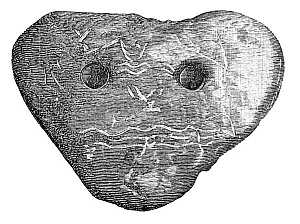
Fig. 19.—Carved "Gorget" from the Hansell Farm.
Strongly in support of the authenticity of the Lenape Stone and its honest discovery, are the two carved stones, figs. 19 and 20, recently discovered on the Hansell Farm, while the present paper was preparing, and proving that, however rare in other localities, small stones were not infrequently carved in this neighborhood. Dr. Putnam "sees no reason to doubt their authenticity," and Professor Shaler, of Harvard College, to whom the writer has shown fig. 19, says: "If, upon comparing the incised lines with those on the Lenape Stone, it appears that they have the same character—i. e., the same shape of furrow,—then you will undoubtedly add a good deal to the weight of evidence in favor of the antiquity of the other ornament."
Considering, however, the variety of lines which may be cut with a flint instrument, we would hesitate to assign [Pg 84] great importance to this comparison. An examination with the microscope proves that the lines on the gorget, fig. 19, are not so neatly and deeply cut as those on the Lenape Stone, and that the bottoms of the grooves are more rounded. While most of the lines on the banner stone, fig. 20, "tapering into points," seem as deeply and clearly cut as those of the mammoth outline, the microscope shows few, if any, scratches on the surface of the grooves, which bear all the traces of long exposure to the weather.
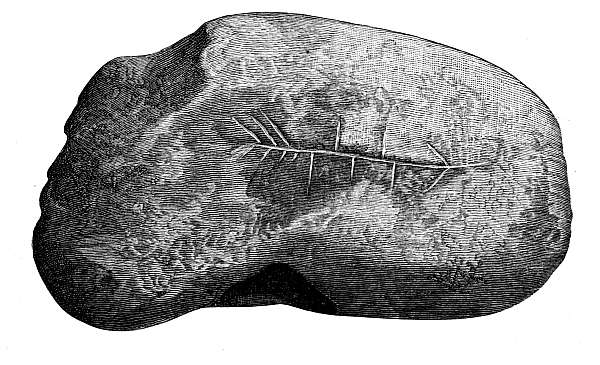
Fig. 20.—Carved Banner Stone from the Hansell Farm.
The writer has made several efforts to obtain opinions upon the Lenape Stone from modern Indians, particularly Delawares, in the West and in Canada. Mr. Horatio Hale, of Toronto, who kindly showed photographs of the carvings to several Indians in Canada, among whom were [Pg 85] some very intelligent Delawares, says that "they thought that the Stone showed Indian workmanship, and would have been inclined to consider it authentic but for the mammoth, which perplexed them. They had never heard of such a creature, and, fearing a hoax, were shy of saying much about the symbols on the reverse side of the Stone; the pipes would naturally, they said, indicate a treaty; the snow-shoe, that some of the tribes concerned came from the North; and the tortoise, hawk, deer, etc., would be the marks or totems of the different tribes; with regard to the doubtful figures, they could give no explanation."
Of course, the value of these opinions would in each case depend upon the tribe to which the Indian belonged, and how far his former knowledge of a pictographic art or the traditions of his race may have been lost by many years of contact with the whites.
The strong resemblance of the pipe figure (l) to the modern Sioux calumets, made of catlinite or red pipe-stone from the famous quarry in Southwestern Minnesota, has been spoken of as another objection to the authenticity of the Stone. The form does not occur, as far as the writer can learn, in any of the ancient rock-writings of the eastern Algonkins, and no pipes of exactly the Sioux shape, which Mr. E. A. Barber, of Philadelphia, considers the most modern of Indian pipe-forms, have as yet been discovered in the ancient Delaware era, nor even in the mounds. [Pg 86]
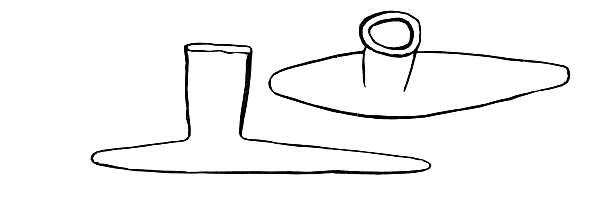
Fig. 21.
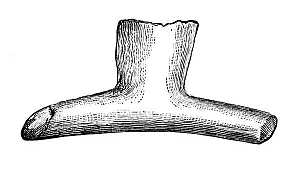
Fig. 22.
On the other hand, the profile of the Sioux form itself could not more closely correspond with the minute outline, which is too small, perhaps, to be taken very strictly, than does the profile of fig. 21—a pipe now in the Archæological Museum, at Salem, Mass., and found by Dr. Putnam, in an ancient Indian grave near Beverly, Mass.
The other pipe figure on the stone might easily have been suggested by the form from the mounds, with a slightly curved base (fig. 22), now in the Peabody Museum at Cambridge, Mass., and discovered in a mound in Ohio. [Pg 87]
Schoolcraft, who has been more explicit than other writers respecting the picture-writings of the North American Indians, speaks of two distinct pictographic systems among the Algonkin tribes, called by them respectively Kekeewin and Kekeenowin. The first appeared to be their method of recording facts of every-day occurrence, and embraced the heraldic devices used upon the grave posts—the communications written upon birch bark, and the caution marks, itinerary, hunting, and war records inscribed upon the trunks of blazed trees by travelling bands, to communicate intelligence to their comrades in the forest. These writings, the signs of which were carefully taught to the young, like the language of signs common at present to a majority of the Western tribes, could be understood by any Indian. Loskiel, the Moravian missionary, who makes frequent mention of picture records, states that "it gave the Indians great pleasure if one halted on coming to such a tree, and listened to their description of the great chief and his exploits thereon inscribed."
The Kekeenowin, on the other hand,—the pictographic system of the prophets, jugglers, and medicine-men,—was far less generally understood by the Indians themselves. It was the method used in the historical records, sung before the tribe at religious feasts and dances, and was likewise invariably employed in the incantations of the priests, prophets, and medicine-men, of which Schoolcraft gives seven kinds relating to medicine, necromancy, revelry, hunting, prophecy, war, and love.
The chief characteristic of the Kekeenowin is the fact that in it each symbol recalled to the mind of the reader [Pg 88] learned in the art a song, previously committed to memory by him in connection with the symbol, and the general idea of which was more or less arbitrarily connected with it. "The words of the song," says James, in his appendix to Tanner's narrative, "were not variable, but must be learned by heart, otherwise though from an inspection of the figure the idea might be comprehended, no one would know what to sing." The main object, however, was the preservation of the songs, which the priests, on consulting their birch-bark scrolls or painted wooden tablets, were thus enabled to sing at the great feasts, giving the many verses in their proper order. The connection between the symbol and the idea expressed by the song was often beyond the power of divination to the uninitiated, and the key to these sacred incantations, a knowledge of the songs, once lost, could never be recovered, as it was doubtless far from the intention of the priests that the uninitiated Indian should divine their mysteries from an inspection of the symbols. It was only upon the payment of many beaver skins, says Tanner in his narrative, that he was permitted to learn the mystic signification of the twenty-seven symbols of the Chippeway song for medicine hunting, which it took him more than a year to learn.
The historical records, however, were sometimes, it appears, written in Kekeewin and sometimes in Kekeenowin; some were related in songs, others were not. Those inscribed upon painted wooden tablets, or the bark [Pg 89] scrolls, and pieces of slate alluded to by George Copway, were doubtless generally sung at stated occasions before the tribe, while the Muzzinabicks or rock-writings upon the face of cliffs and boulders, as at "Bald Friars" and "Miles Island" on the Susquehanna or West River, and Bellows Falls, Vermont, at the Cunningham Islands, Lake Erie, or upon the famous Dighton Rock at Fall River, Mass., although including many of the characters seen in the song records were probably not expressed in songs.
Another version of the big-buffalo tradition is found in Rembrandt Peale's pamphlet on the mammoth, published in Philadelphia in 1803. Notwithstanding the highly colored style of the translation the ideas expressed seem to be those of the Indian. It reads as follows: "Ten thousand moons ago, when naught but gloomy forests covered this land of the sleeping sun, and long before the pale men, with thunder and fire at their command, rushed on the wings of the wind to ruin this garden of nature, when naught but the untamed wanderers of the woods, and men as unrestrained as they, were lords of the soil, a race of animals existed, huge as the frowning precipice, cruel as the bloody panther, swift as the descending eagle, and terrible as the angel of night. The pines crashed beneath their feet, and the lake shrunk when they slaked their thirst; the forceful javelin in vain was hurled, and the barbed arrow fell harmless by their side. Forests were laid waste [Pg 90] at a meal, the groans of expiring animals were everywhere heard, and whole villages, inhabited by men, were destroyed in a moment. The cry of universal distress extended even to the region of peace in the west, and the Good Spirit interposed to save the unhappy. The forked lightning gleamed aloud, and loudest thunder rocked the globe. The bolts of heaven were hurled upon the cruel destroyers alone, and the mountains echoed with the bellowings of death. All were killed except one male, the fiercest of the race, and him even the artillery of the skies assailed in vain. He ascended the bluest summit which shades the source of the Monongahela, and roaring, aloud, bid defiance to every vengeance. The red lightning scorched the lofty firs, and rived the knotty oaks, but only glanced upon the enraged monster. At length, maddened with fury, he leaped over the waves of the west at a bound, and at this moment reigns the uncontrolled monarch of the wilderness, even in despite of omnipotence itself."
If the account of Cusic and the Lenape traditions concur in solving the mystery of the mound-builders, and proving their identity with the Allegewi of the Lenape tradition, the evidence is strengthened by the concurrent testimony of language, which, as Mr. Hale and others have shown, renders it probable that the conquered race, [Pg 91] fleeing down the Mississippi, were received and adopted by the Choctaws and Cherokees, who thus became in part their descendants. Both the language of the Cherokees lying to the southeast of the mound-builders' dominions, and who claim to have built the Grave Creek mound, and that of the Choctaws lying to the southwest, have in their vocabularies been largely recruited from a similar foreign linguistic element. One remnant of the Allegewi mingling with their conquerors, the Talamatan or Hurons, became in part the ancestors of the Cherokees. Living to the southeast of the mound-builders' dominions, the Cherokees had their council lodge on the summit of a vast mound, the construction of which they ascribed to a people who had preceded them. In grammar their language resembled the Huron-Iroquois, while in vocabulary it has been largely recruited from some foreign source.
The other remnant of the vanquished Allegewi, fleeing down the Mississippi "to the southward," would have been received and protected by the warlike Choctaws, themselves a mound-building people in comparatively recent times, and the peculiar foreign element in whose language, which differs considerably from that of the sister Creek and Chicasaw nations, would thus be explained. [Pg 92]
JANUARY 8, 1885.
While the foregoing pages were in course of publication, the carved "gorget" (fig. 23) was found on the Hansell farm, on Thursday, January 8, 1885.
The circumstances of the discovery were as follows: Late in the autumn of last year—1884—the writer had caused an excavation to be made at a spot in one of the fields on the Hansell property, where the carved stone (fig. 19) had been found. At this place the soil of the field, a yellowish clay, was very noticeably discolored as if by the fires and decayed refuse of aboriginal dwellings; the discolored spot was of a dark brown color, and covered an area of about twenty square yards.
The excavation measured about 25 feet in length by 4½ feet in width, and about 3 feet in depth. The dark brown stratum had a depth of 1½ to 2 feet, and beneath it appeared the yellow clay of the surrounding field. The place was at a distance of about a quarter of a mile from the spot where the Lenape Stone had been found. In digging the trench many small stones were thrown up, but no human remains or implements were discovered. The earth was not thrown through a sieve. As the excavation was to have been continued in the spring, the trench and pile of earth were left undisturbed.
Bernard Hansell, the discoverer of the Lenape Stone, states that he found the carved gorget (fig. 23) in this heap of earth on Thursday the 8th of last month; his [Pg 93] brother had previously found there several flint chips, and Hansell had gone to the spot, on the day in question, expressly to look for "Indian relics."
The day was warm and the trench full of water. The field was very muddy. Hansell found the stone, the perforation in which had attracted his attention, protruding a little from the mud on the outside of the heap, and in the yellow earth last thrown out. Without displacing it, he returned to the house, and brought his brother, William Hansell, to the spot, that the latter might witness his discovery. Then removing the stone from the mud, he washed it in the water of the trench, not rubbing it, but holding it in the water for about five minutes. The mud clinging to it, having melted and frozen several times within a few days, was very soft and dissolved easily. On the same day Hansell informed the writer of his discovery in a letter.
The stone is a soft, red shale, similar in appearance to the Lenape Stone. Unlike the specimens (figs. 19 and 20) found on the surface of the ground, its surface presents a very polished and rubbed appearance, as if it had been subjected to long wear after the carvings had been made. The lines, the edges of which are much worn and rubbed, do not seem sharply and deeply cut, as those of fig. 20 or the Lenape Stone, and the bottoms of the grooves, to which the soil still clings, appear rounded, as if cut with a dull point—as in the case of the shallow incisions upon fig. 19. [Pg 94]
The discovery of this stone in the clayey soil, beneath the black stratum above mentioned, and where it had lain for an indefinite period beyond the reach of the ploughshare, would account for its polished appearance and the absence of weathering upon its surface—the conditions of its discovery generally corresponding with those in the case of highly polished implements found in the mounds.
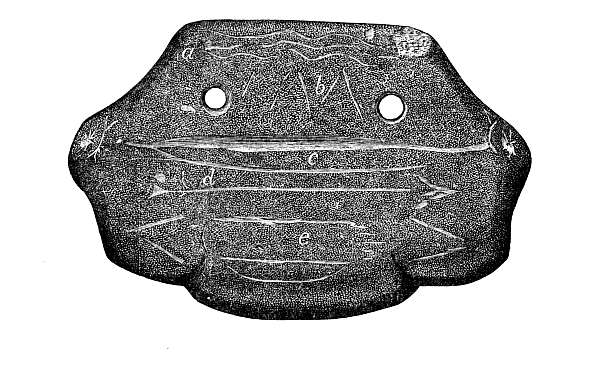
Fig. 23.—(Natural size) Carved "Gorget" Found on the Hansell Farm, January 8, 1885.
The design consists of: (a) three waving lines representative of water; (b) three points between the perforations, referring probably to wigwams—possibly an allusion to the triple clanship of the Lenapes and their settlement by the Lenape whittuck or Delaware River; (c) a bow; (d) an arrow; and (e) a quiver.
The design on the reverse side, of which we here give a rough outline (fig. 24) consists mainly of a series of circular [Pg 95] waving lines, representative probably of water; numerical dots and "tallies"; and three triangular outlines, common Indian symbols for the human figure, and again suggestive perhaps of the Wolf, Turtle, and Turkey brotherhood of the Lenapes.
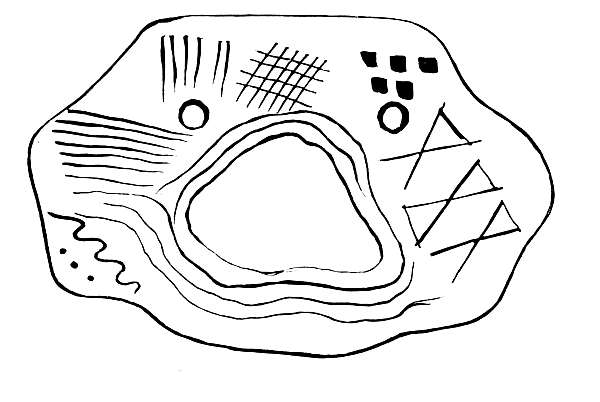
Fig. 24.—Reverse of fig. 23.
[B] Nothing seems to contribute so much to the problem of their use as the absence, in most cases, of any sign of friction around the holes. Similar stones have been recently seen in use by the Pah-Utes of Southern Nevada, "for giving uniform size to their bow-strings," yet the clean edges of the perforations make it impossible to believe that these stones could have been used for such a purpose, while the difficulty of supposing they could have been used as buttons, or that they could have been suspended at all is almost as great, unless we adopt the very ingenious theory of Dr. F. W. Putnam, i. e., that the raw deer thong used for suspending them, and forced tightly through the holes, becoming hard when dry, remained motionless in its place, and rendered friction impossible.
[C] See an interesting little book, from which we here quote, entitled "Mastodon, Mammoth, and Man." By J. P. McLean. Cincinnati, 1880.
[D] A term, says Filson (Imlays' Topographical Description of the Western Territory, 2d Ed., p. 276) formerly applied by the Indians "to the fertile region now called Kentucky."
[E] A word meaning "hog" in modern Iroquois.
[F] "Notes of a Military Reconnaissance from Fort Leavenworth to San Diego, Cal.," Col. W. H. Emory, Washington, 1848, p. 90.
[H] Heckewelder states that he had himself seen "many of these fortifications, —of course the works of the mound-builders. He mentions in particular two "entrenchments" along the Huron River, and several large flat mounds near them, in which were buried, as he learned from the Indians, hundreds of the Alligewi, slain in the bloody wars which the narrative proceeds to mention.
[I] This view coincides with the opinion of the Indians who have seen the carving since the above was written.
[J] The point projecting behind the handle in the figure reminds us forcibly of the shape of the modern iron tomahawk; yet that stone axes of this shape were anciently in use among the Indians was proved by the discovery of the "Thorndale Axe" with a similar projection, and found in the original wooden handle, now at the Museum of Natural History in New York.
[K] The word Namaesi Sipu (Fish River) given by Heckewelder, but published Messussipu (Great River) in Mr. Squier's version of the Wallum Olum, appears Namasipi in the Rafinesque version of 1836, and in the original manuscript now in Dr. Brinton's possession it seems that the latter word has been written over the word Messussipu by the author, who probably had been comparing the account with Heckewelder.
[L] See article on "Indian Migrations" by Horatio Hale, American Antiquarian, Jan.-April, 1883.
[M] On the other hand, how shall we account for the occurrence of the word Messusipu in the Wallum Olum, or, more exactly, in the Rafinesque copy of it—the only version we possess?
Messusipu is derived, says Squier, from the Algonkin words Messu, Messi, or Michi (great), and Sipu (river).
The name Mississippi is of Algonkin origin, and has the same etymology,—it means "great river." Among the Algonkin tribes living to the north and along the eastern shore of the Mississippi, the Sauks called it Mecha-sapo, the Menomonees Mecha-sepua, the Kicapoos Meche-sepe, the Chippeways Meze-zebe, and the Ottawas Missis-sepi; Mecha, Meche, Meze, Missis, meaning "great," and sapo, sepua, sepe, zebe, and sepi, "river." (Wisconsin Hist. Col., ix., 301.)
The Lenape word Messusipu must therefore refer to the Mississippi. Yet we may suppose that Rafinesque had written the word by mistake in his copy of the Wallum Olum, a supposition which gains strength from the fact that Messusipu plainly appears in his manuscript to have been changed to Namasipi. Had he been comparing his copy with the original "painted sticks" or some other Indian authority not mentioned? or did he merely borrow the word Namasipi from Heckewelder? Again we may suppose the word Messusipu to have been an indefinite term applied by the Lenape to more than one of the great streams crossed by them in their migrations.
